You know it’s spring when the annual garden tours start popping up. The Piedmont Gardeners club in Athens, Georgia recently hosted their spring tour. It was the 26th year for this popular event.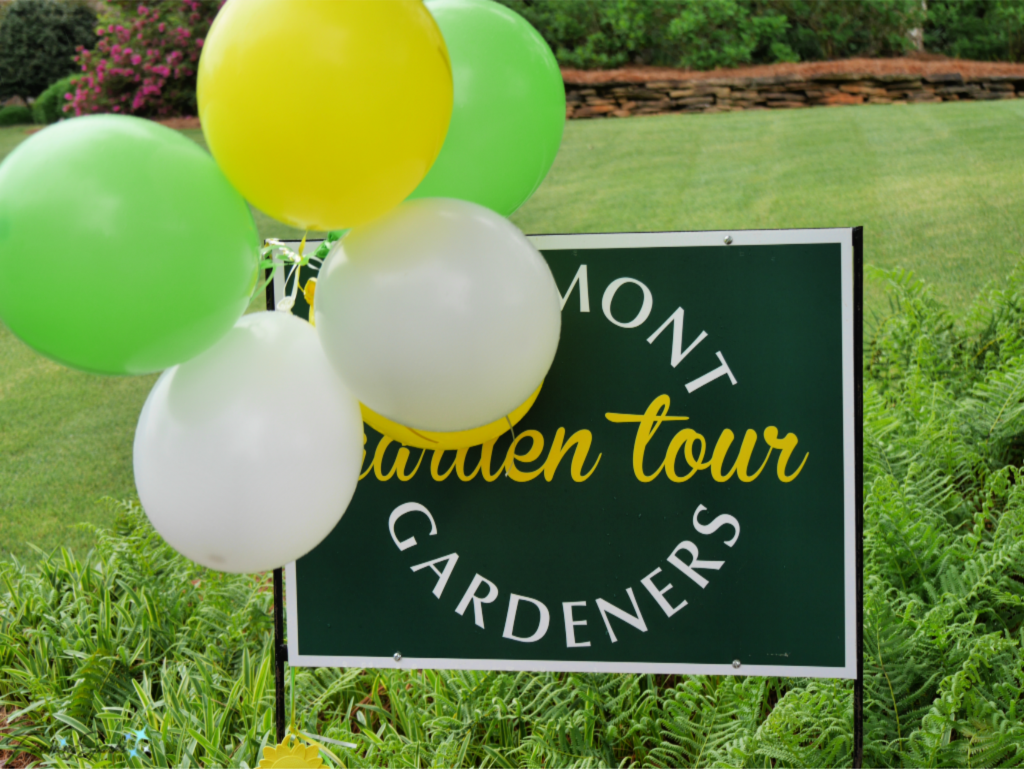 The tour included 5 great gardens and encouraged visitors to “immerse yourself in this self-guided tour filled with garden creativity and ideas”. I followed those instructions to the letter and immersed myself in 4 beautiful gardens. Today I’d like to share some of the creativity and ideas from those gardens.
The tour included 5 great gardens and encouraged visitors to “immerse yourself in this self-guided tour filled with garden creativity and ideas”. I followed those instructions to the letter and immersed myself in 4 beautiful gardens. Today I’d like to share some of the creativity and ideas from those gardens.
The Johnston garden on Oaklake Circle was the first garden I visited. This beautifully manicured space was a brilliant blend of formal and casual. Here’s an example of how the perfect symmetry, near the garden’s entrance, sends a formal message.
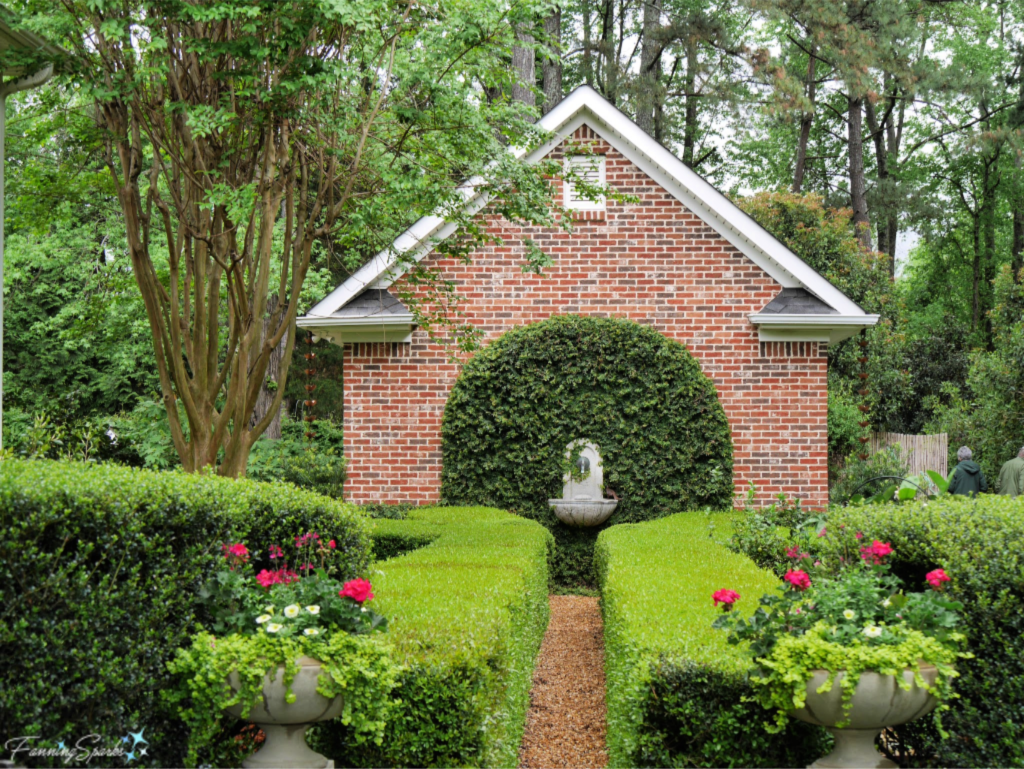 But just around the corner, this delightful scene took the edge off the formality. And, yes, that’s a rock alligator in the green grass! I love how the gardener used a variety of grasses and plants to “paint” this scene.
But just around the corner, this delightful scene took the edge off the formality. And, yes, that’s a rock alligator in the green grass! I love how the gardener used a variety of grasses and plants to “paint” this scene.
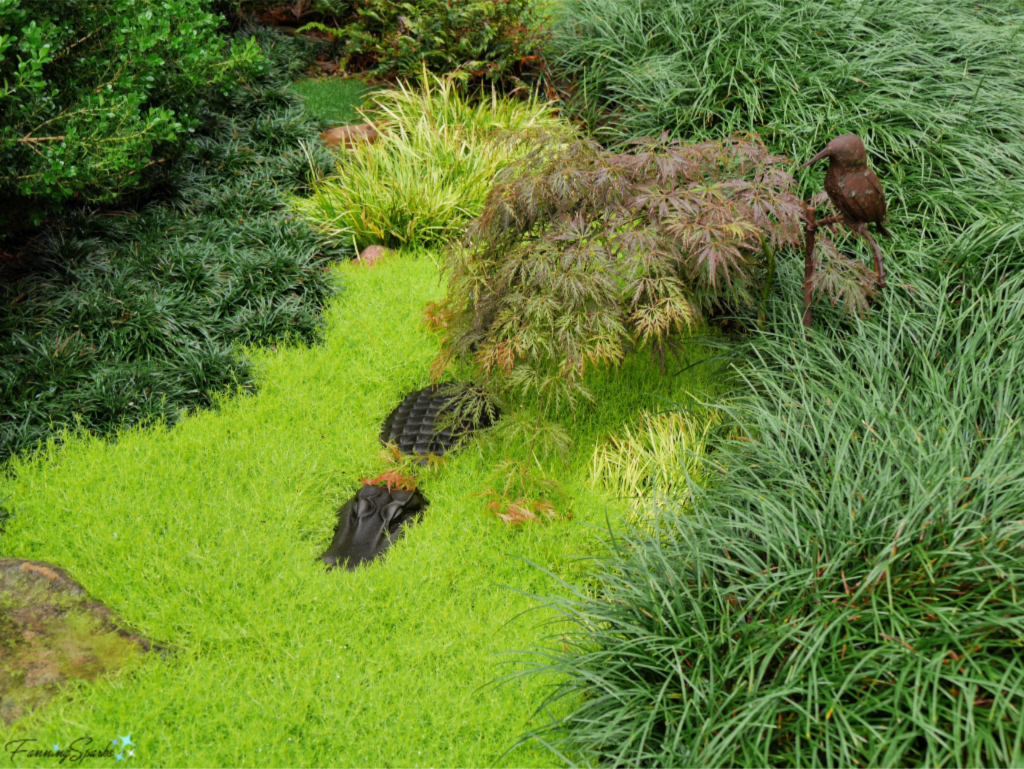 Touches of whimsy, like this bird sculpture, kept things light and fun.
Touches of whimsy, like this bird sculpture, kept things light and fun.
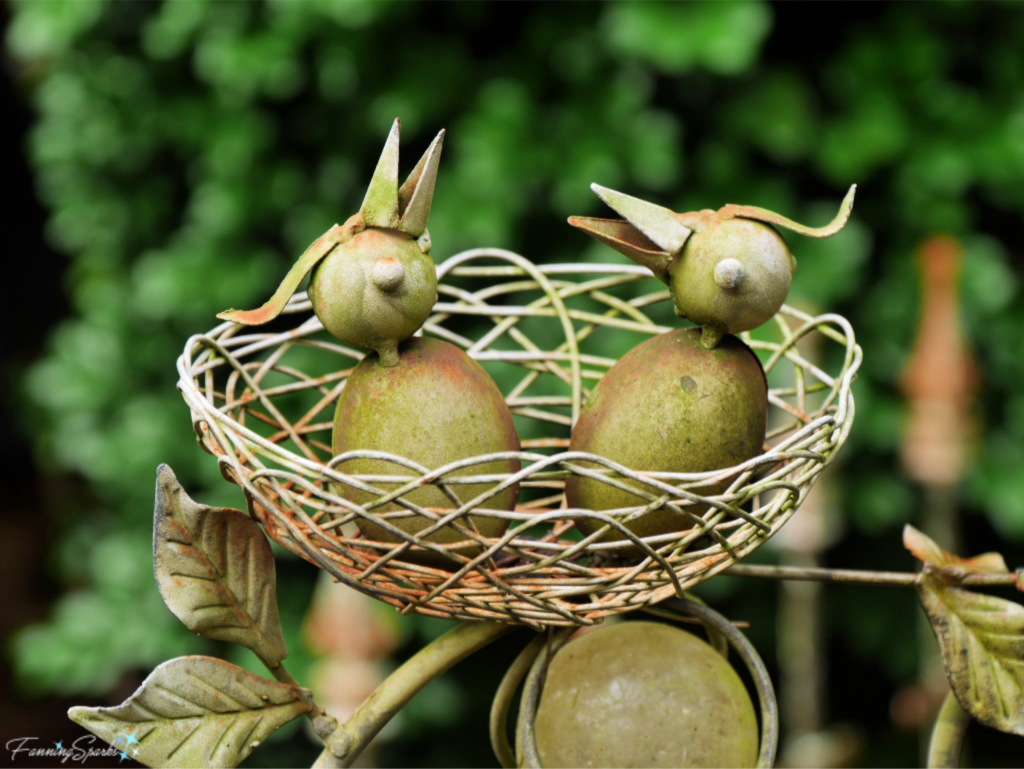 This gardener strategically placed large potted plants throughout the garden. It’s a great way to vary height and add interest. Planting a delicate ground cover at the base of the potted tree helps the pot blend in and hides the potting soil. That’s a nice detail I’ve filed away for future reference.
This gardener strategically placed large potted plants throughout the garden. It’s a great way to vary height and add interest. Planting a delicate ground cover at the base of the potted tree helps the pot blend in and hides the potting soil. That’s a nice detail I’ve filed away for future reference.
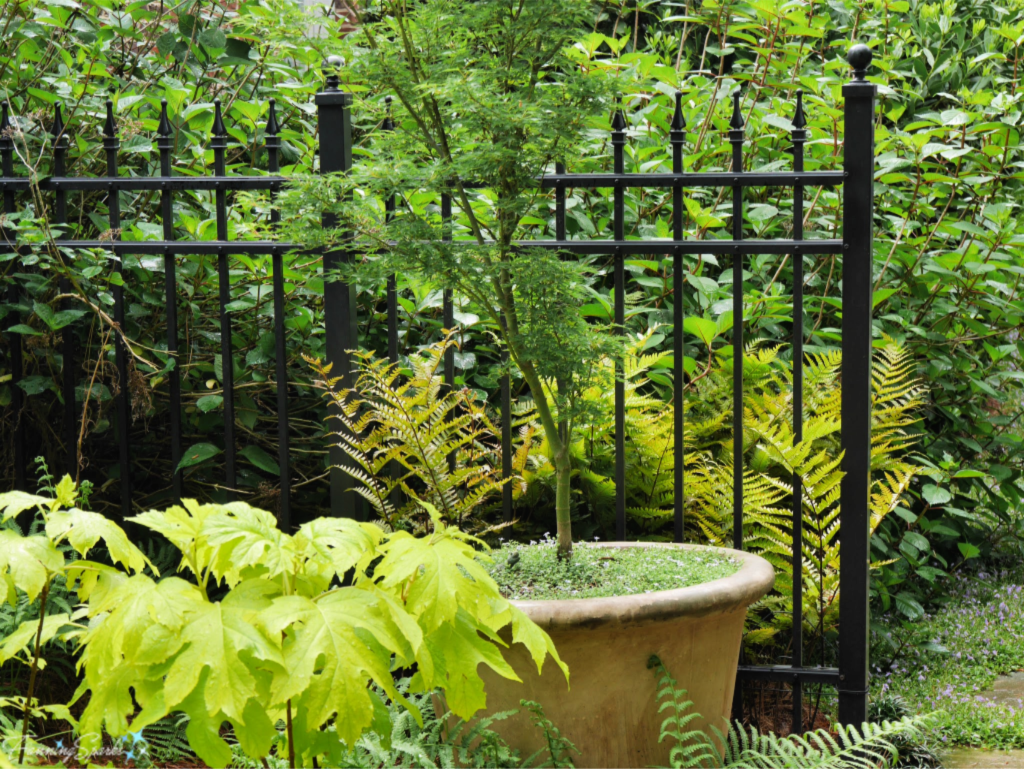 The Cavan garden at Mal Bay Rd had a fun, casual vibe. Here a set of stone steps and a simple arch connect the backyard seating area to a grassed section.
The Cavan garden at Mal Bay Rd had a fun, casual vibe. Here a set of stone steps and a simple arch connect the backyard seating area to a grassed section.
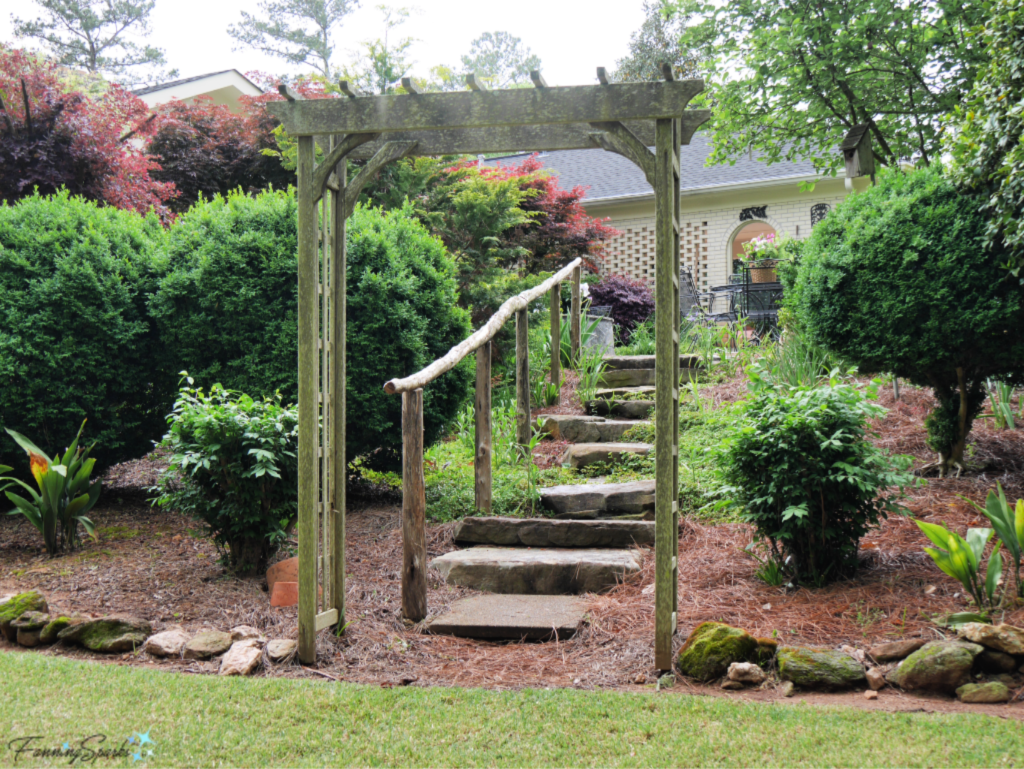 This potting shed caught my eye. It’s situated towards the back of the property, has open walls, a fun collection of vintage items and a delightful, laid back feel.
This potting shed caught my eye. It’s situated towards the back of the property, has open walls, a fun collection of vintage items and a delightful, laid back feel.
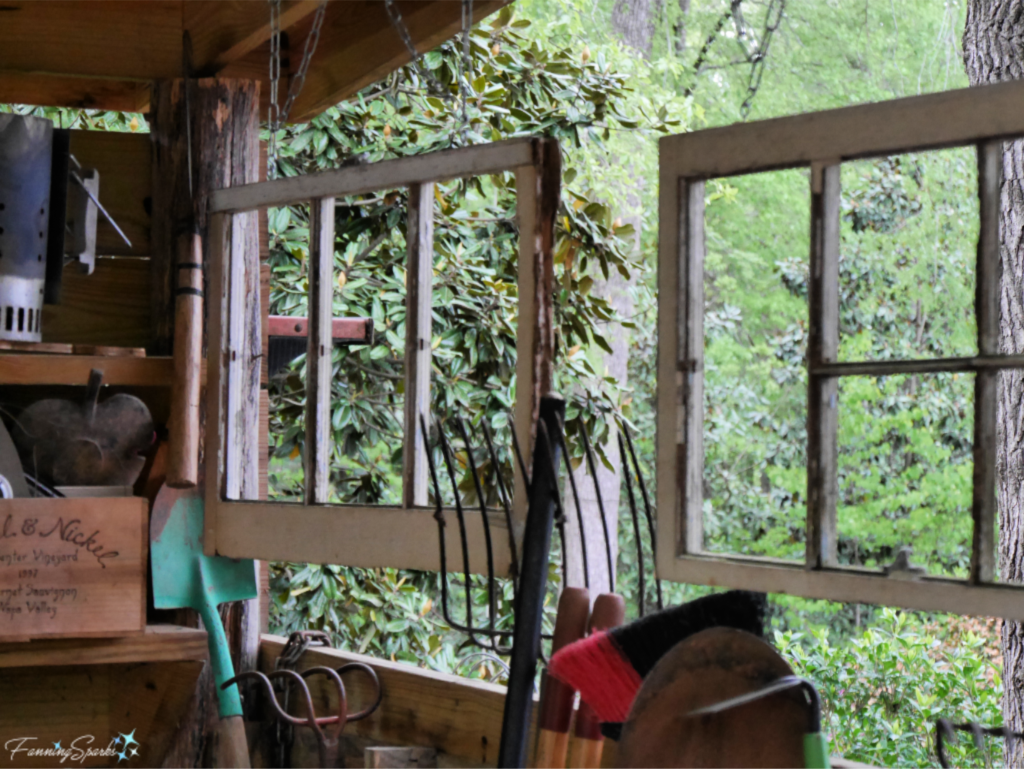
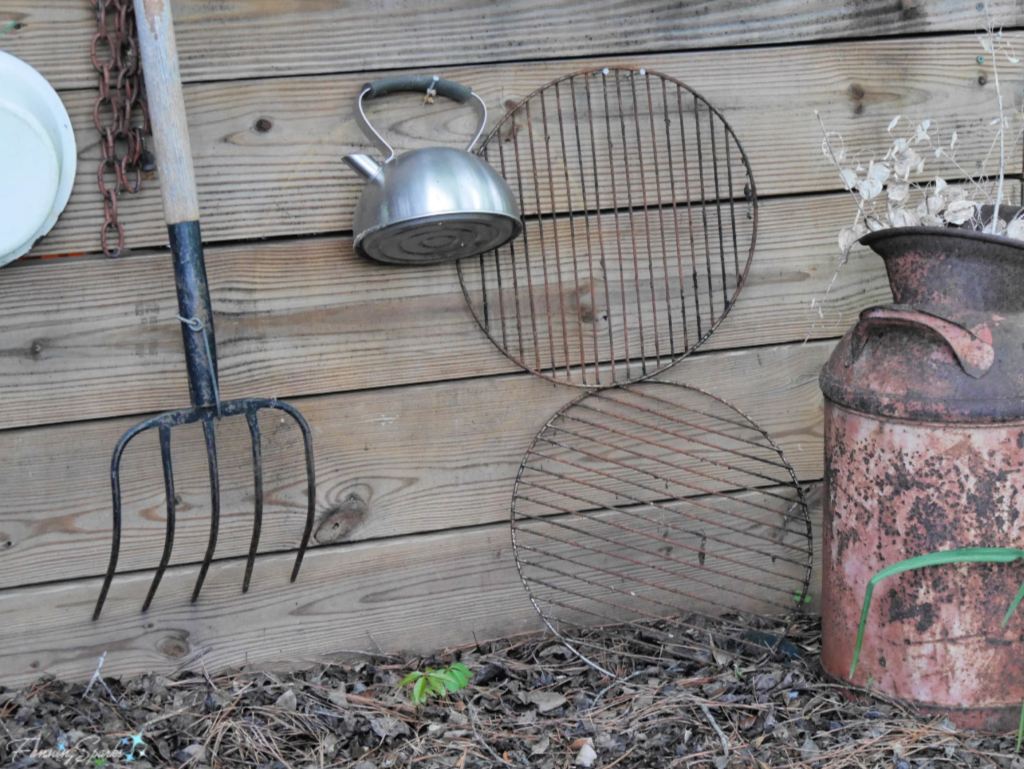
This old-timey swing in front of these beautiful azaleas looks so inviting‒until you realize it might be rather difficult to maneuver. But it sure looks pretty!
 Several casual floral arrangements were placed throughout the seating and eating areas. I rarely think to do this but it’s easy to do and adds such a nice touch.
Several casual floral arrangements were placed throughout the seating and eating areas. I rarely think to do this but it’s easy to do and adds such a nice touch.
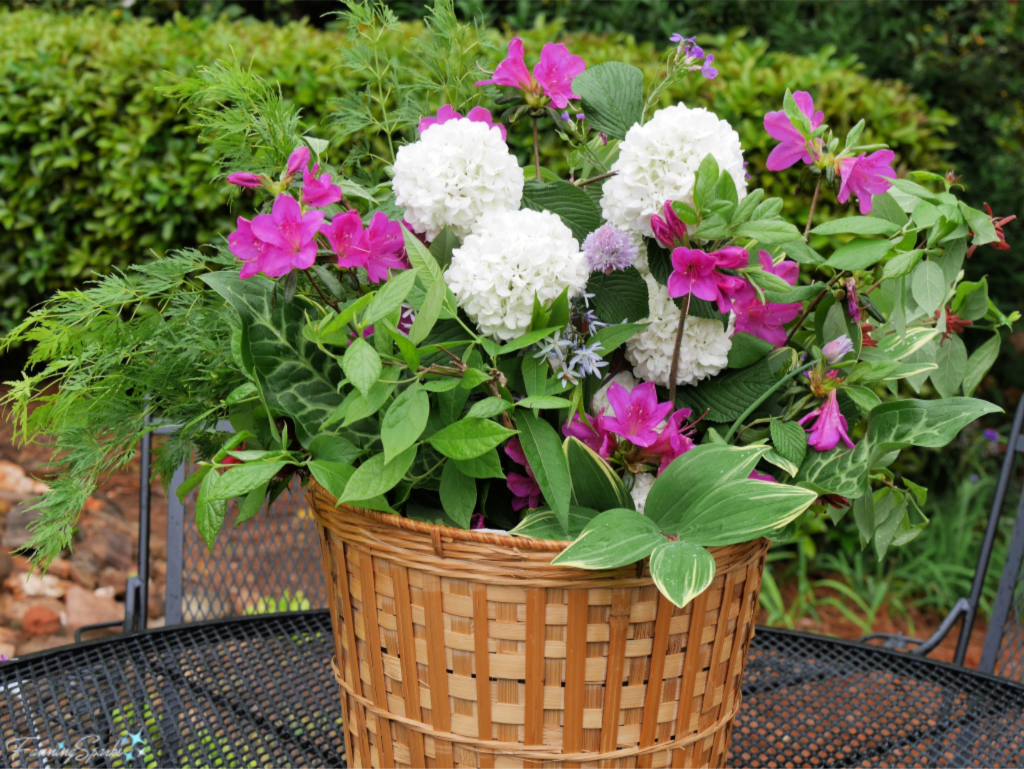 The Carey garden on Fox Trace featured a network of dry streams and bridges leading to this lovely covered seating area.
The Carey garden on Fox Trace featured a network of dry streams and bridges leading to this lovely covered seating area.
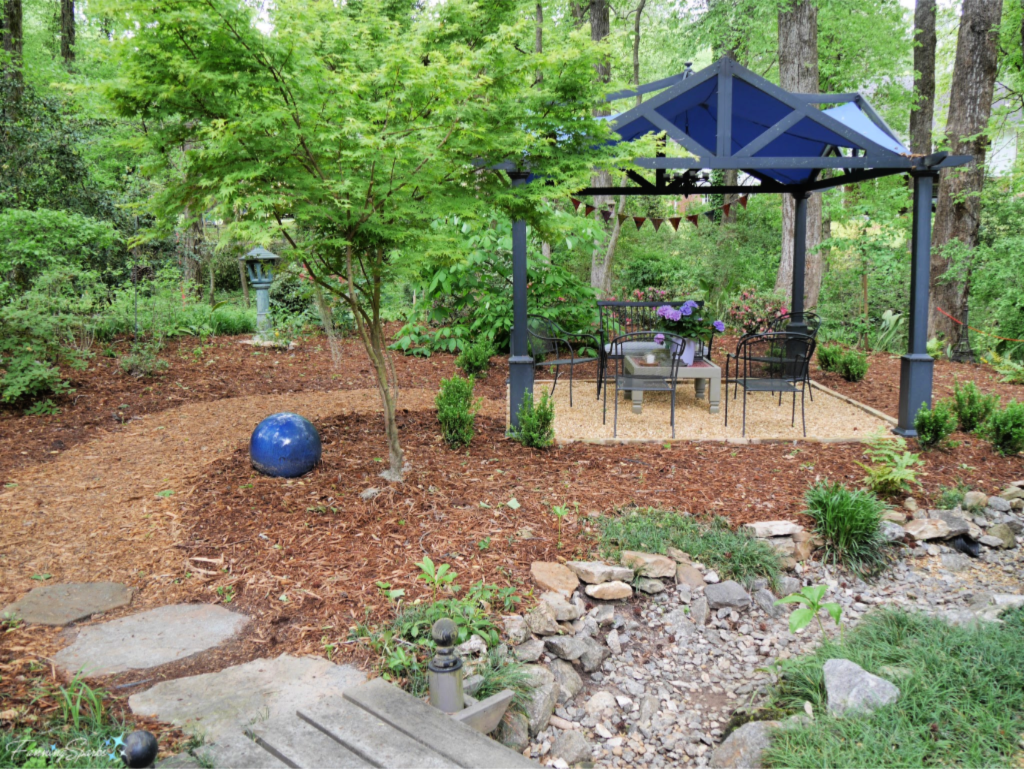 The coffee table adds interest to the seating area with its unusual surface. It reminds me of a vintage heat grate floor register.
The coffee table adds interest to the seating area with its unusual surface. It reminds me of a vintage heat grate floor register.
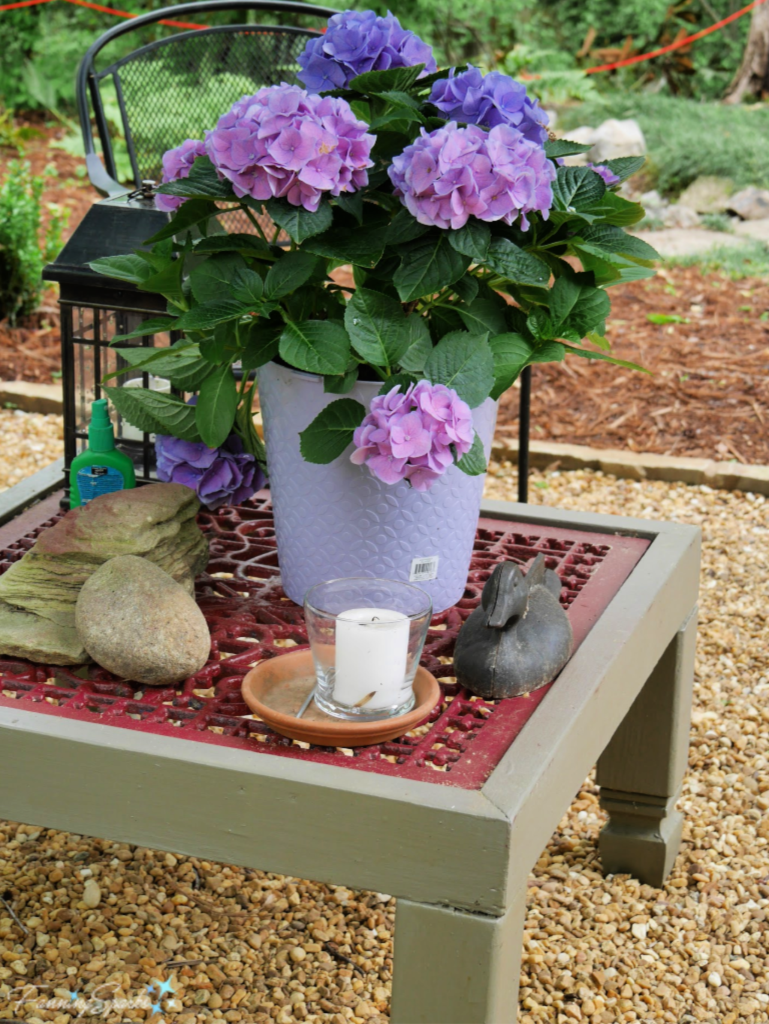 Here’s another take on dressing up the soil under a potted tree. A little driftwood, a few carefully selected stones, and some creeping jenny complete the scene.
Here’s another take on dressing up the soil under a potted tree. A little driftwood, a few carefully selected stones, and some creeping jenny complete the scene.
 I wrapped up my tour with the Middendorf garden on Jefferson River Rd. As it turned out, I saved the best for the last! All the gardens were lovely but the Middendorf garden is located on a 137-acre horse farm, called Silverthorn Farm, which was open for our viewing pleasure. Gardeners often strive to frame views in their designs but not many have vistas like this!
I wrapped up my tour with the Middendorf garden on Jefferson River Rd. As it turned out, I saved the best for the last! All the gardens were lovely but the Middendorf garden is located on a 137-acre horse farm, called Silverthorn Farm, which was open for our viewing pleasure. Gardeners often strive to frame views in their designs but not many have vistas like this!
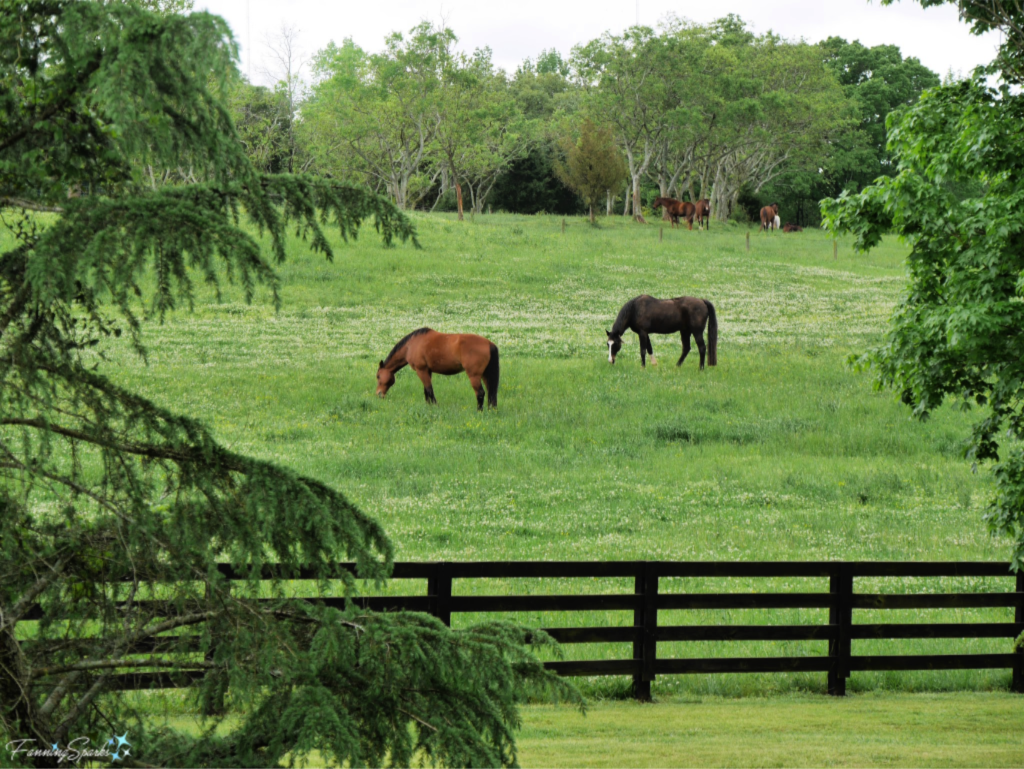 This horse barn is 200 years old and packed with charm and character.
This horse barn is 200 years old and packed with charm and character.
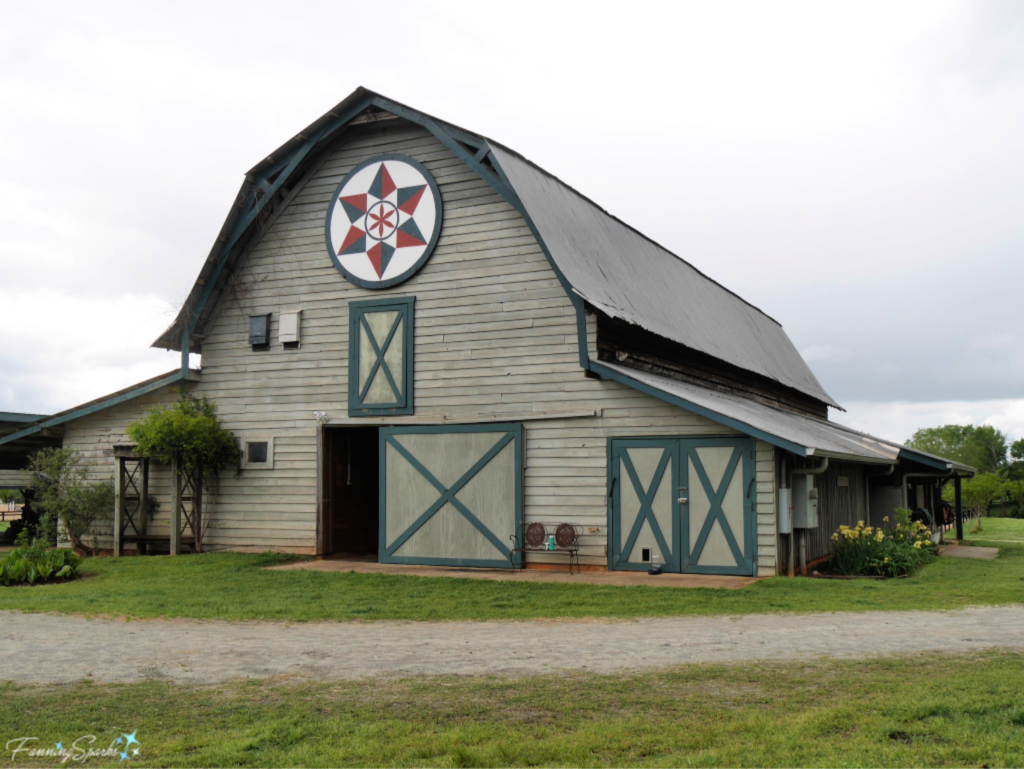
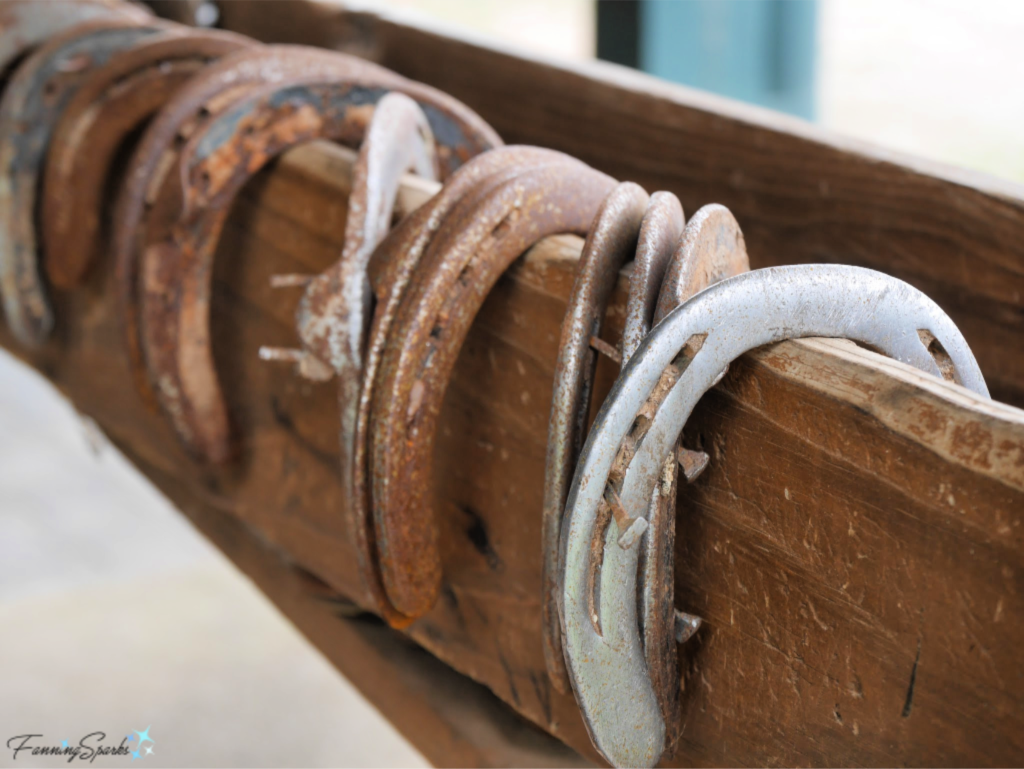 The flower gardens were lovely as well. This enclosed rose garden was at its prime.
The flower gardens were lovely as well. This enclosed rose garden was at its prime.
 The setting was delightful and the roses were splendid. It was the perfect way to wrap up a day of magnificent spring gardens.
The setting was delightful and the roses were splendid. It was the perfect way to wrap up a day of magnificent spring gardens.
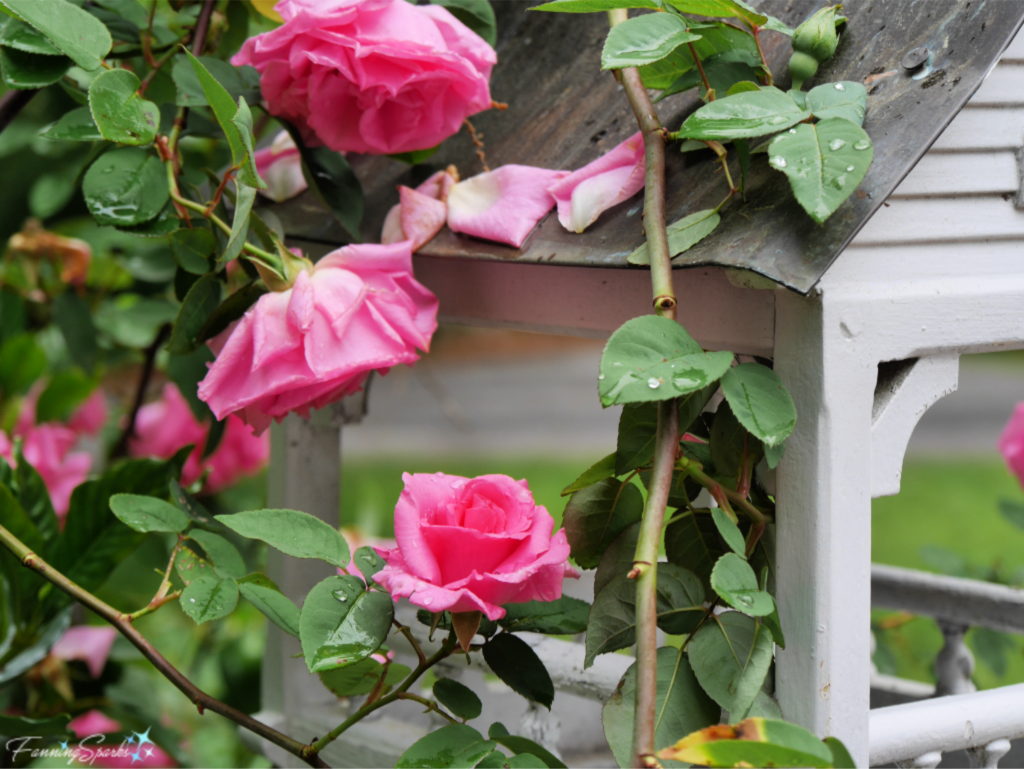
Special thanks to the host gardeners who generously opened their gardens for the tour.
More Info
Garden tours have become a recurring theme here on the FanningSparks blog. Check out these posts:
Charleston’s Glorious Window Boxes
Madison in May – 15 Favorite Fotos.
You can learn more about the Piedmont Gardeners on their website or Facebook page.
Here are a few resources to help you find garden tours:
. Garden tours are often conducted as fund raisers by gardening organizations. Check your local gardening clubs, master gardener organizations, botanical gardens or fundraising organizations for upcoming events.
. In Georgia USA, Walter Reeves’ website provides a handy schedule of gardening events across the state.
. Across the USA, the Garden Conservancy conducts Open Days.
. In the UK, the National Trust is a great resource. Check out their What’s On feature to find scheduled events such as garden tours.
Today’s Takeaways
1. Consider participating in a local garden tour.
2. Viewing gardens is a great source of inspiration for your own yard and garden.
3. Be observant‒appreciate the overall garden and take note of the details.



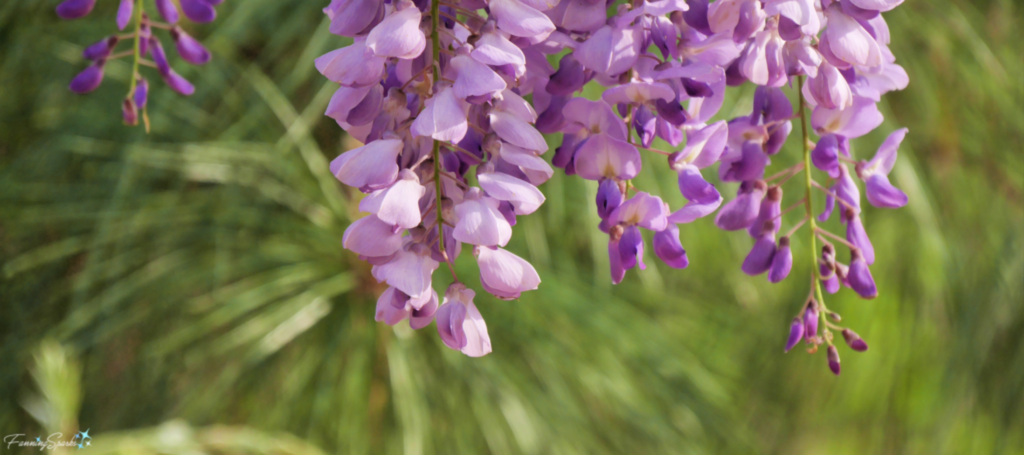
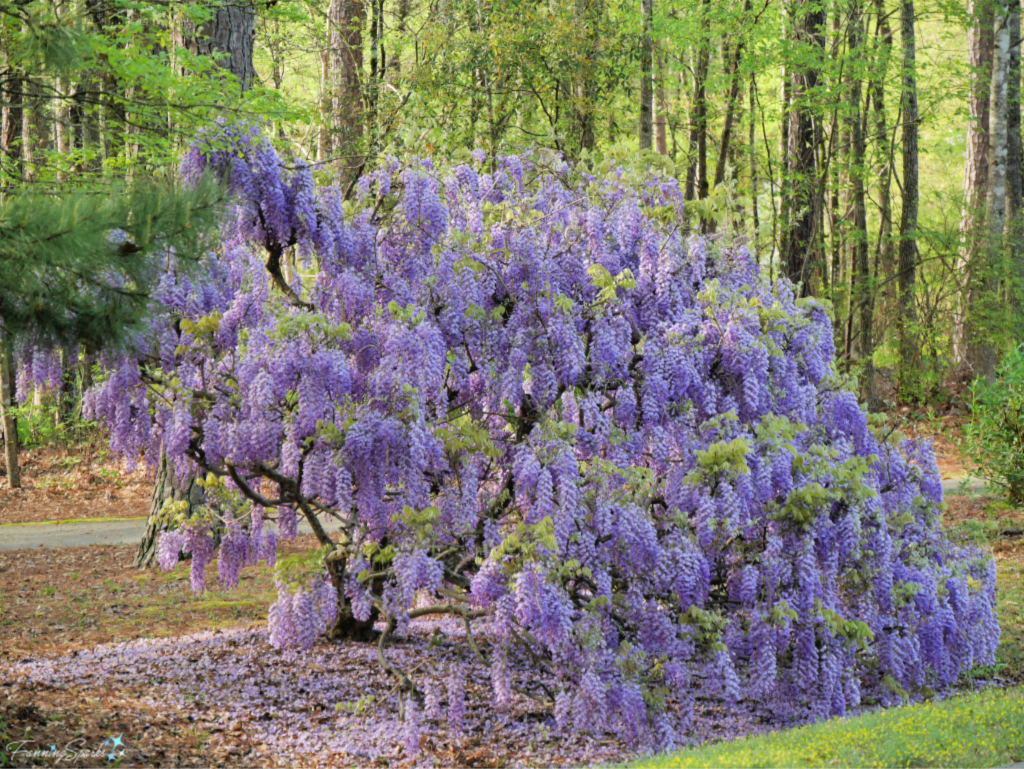 Upon closer inspection, a curtain of rich color and shape came into focus.
Upon closer inspection, a curtain of rich color and shape came into focus. The curtain consisted of dozens of pendulous blooms called racemes.
The curtain consisted of dozens of pendulous blooms called racemes.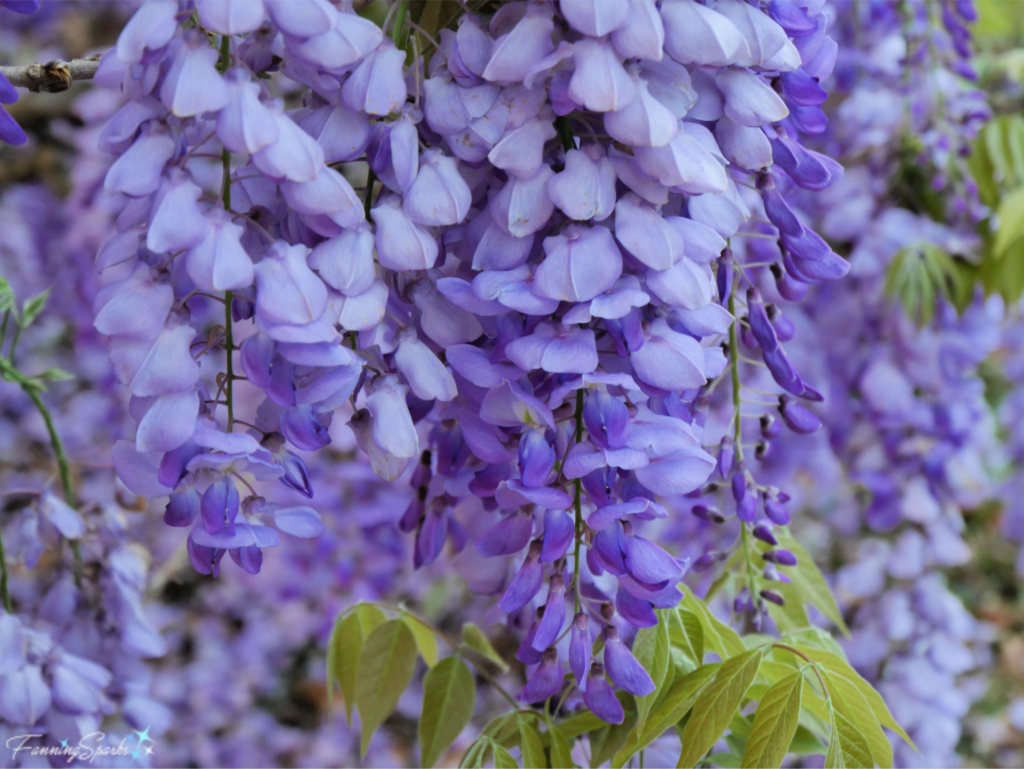 Separate flowers clustered along a central stem to form the raceme. The flowers open from the top down.
Separate flowers clustered along a central stem to form the raceme. The flowers open from the top down.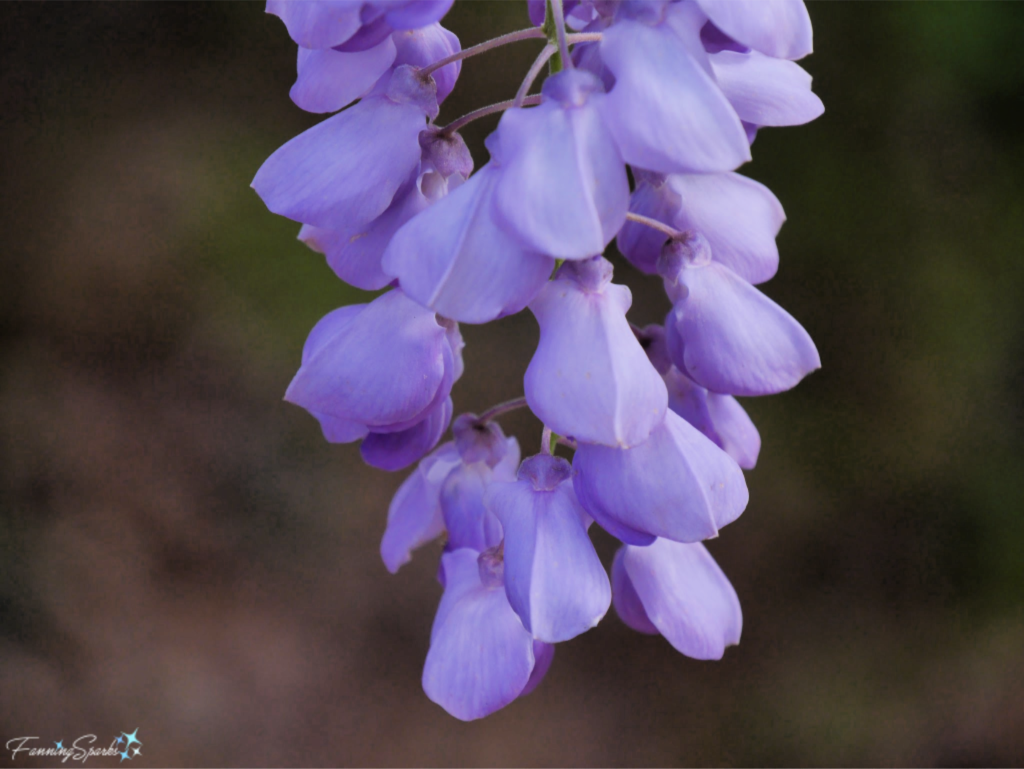 Not only was this wisteria beautiful, it also smelled heavenly. And it created a soft, musical buzz from all the bumble bees that were busy at work.
Not only was this wisteria beautiful, it also smelled heavenly. And it created a soft, musical buzz from all the bumble bees that were busy at work.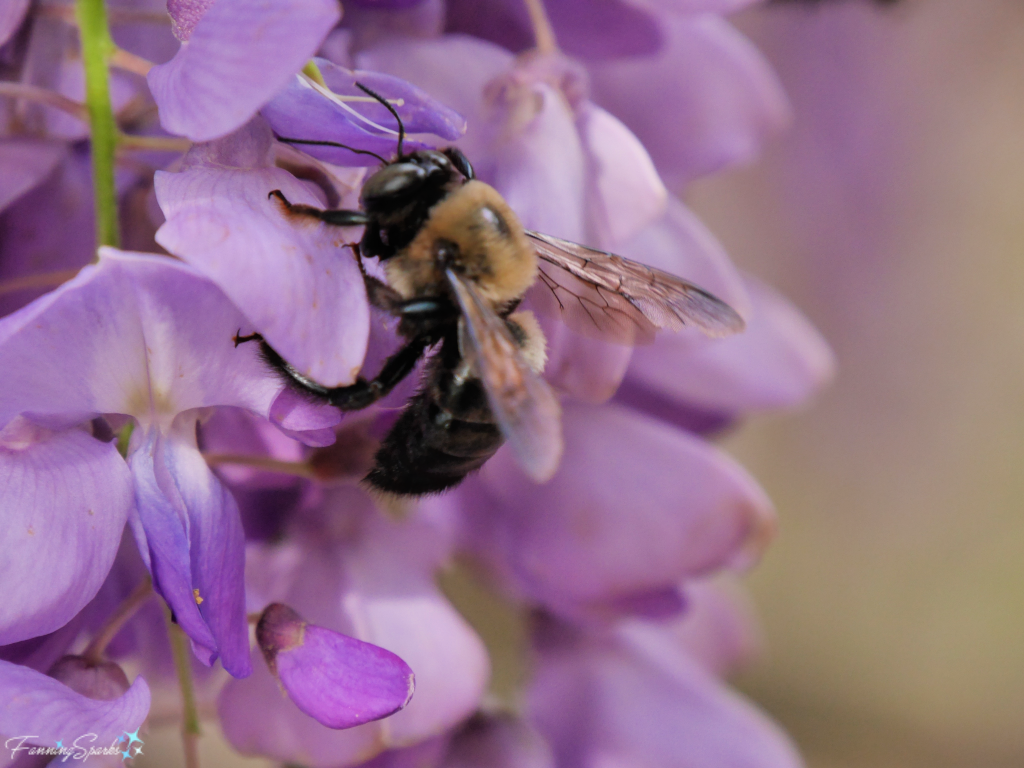 It was so lovely that I couldn’t resist staging a charming spring picnic under the wisteria. Luckily, my neighbor was very accommodating. Thank you, Bill!
It was so lovely that I couldn’t resist staging a charming spring picnic under the wisteria. Luckily, my neighbor was very accommodating. Thank you, Bill!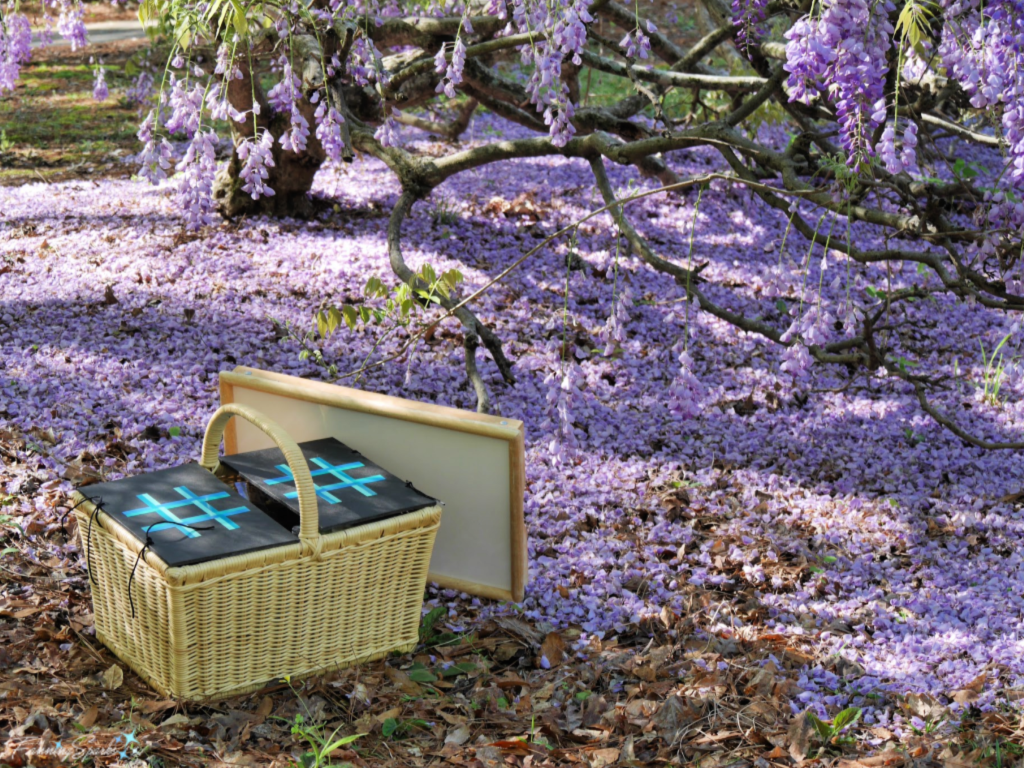 Here’s how it came together.
Here’s how it came together.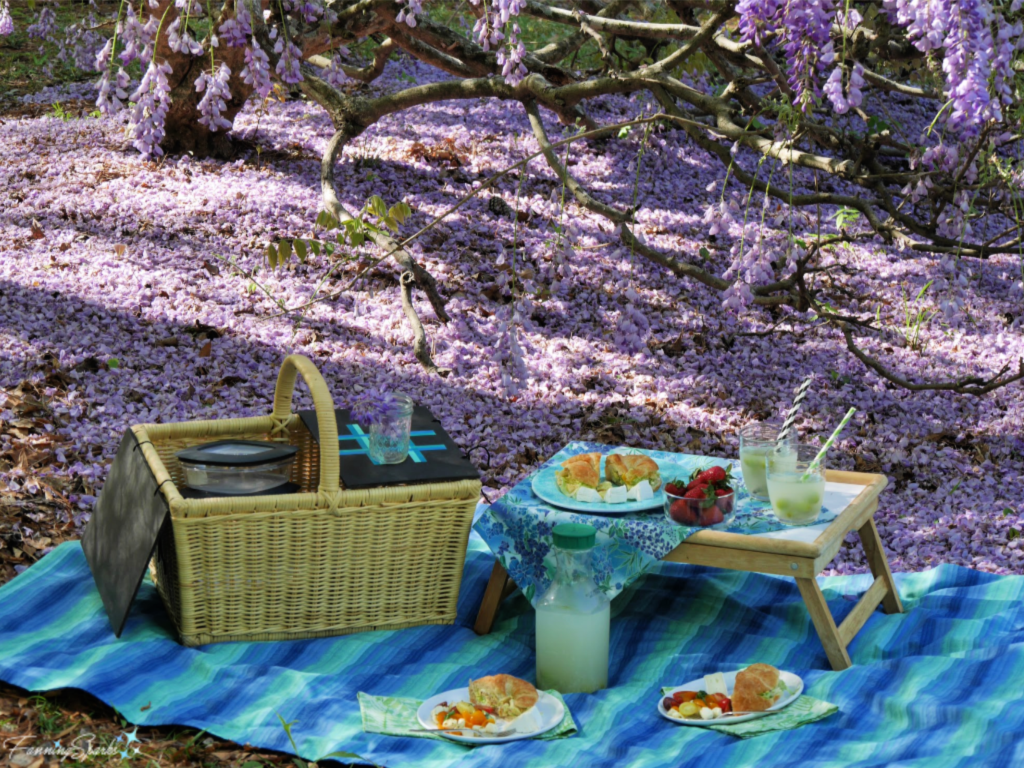 Special thanks to my favorite chef, David, for the curry chicken salad croissants and the caprese salad.
Special thanks to my favorite chef, David, for the curry chicken salad croissants and the caprese salad.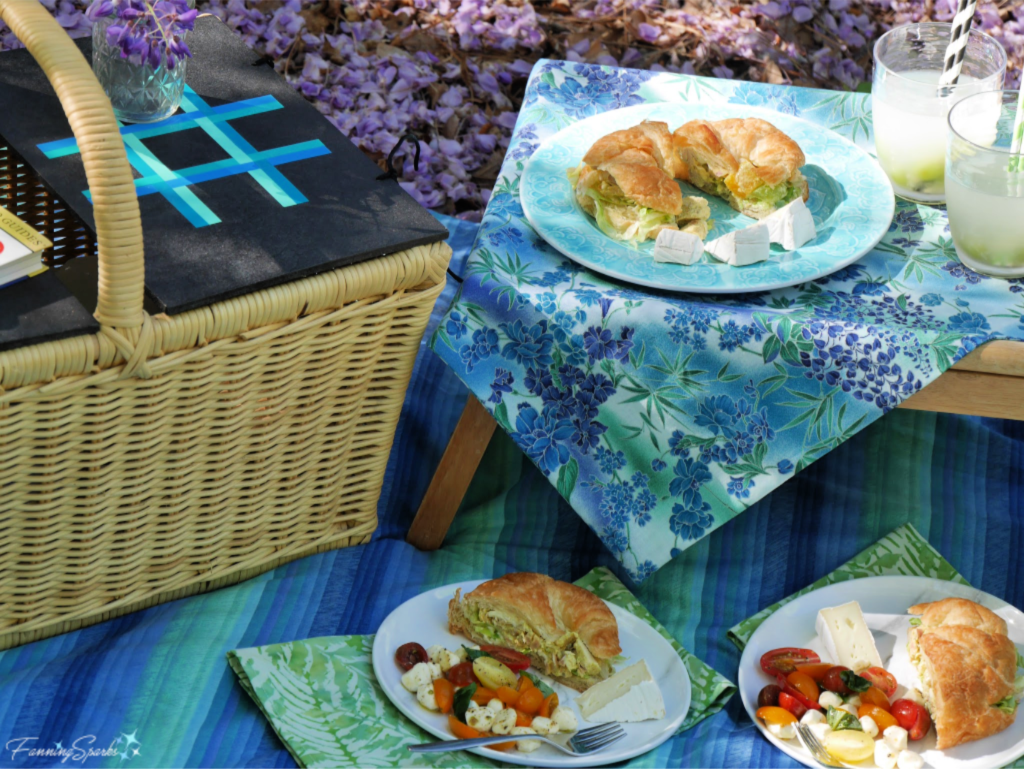 This was my first time using this picnic basket. It was ideal. It’s a generous size, solidly constructed, and the top serves as a handy, little table.
This was my first time using this picnic basket. It was ideal. It’s a generous size, solidly constructed, and the top serves as a handy, little table.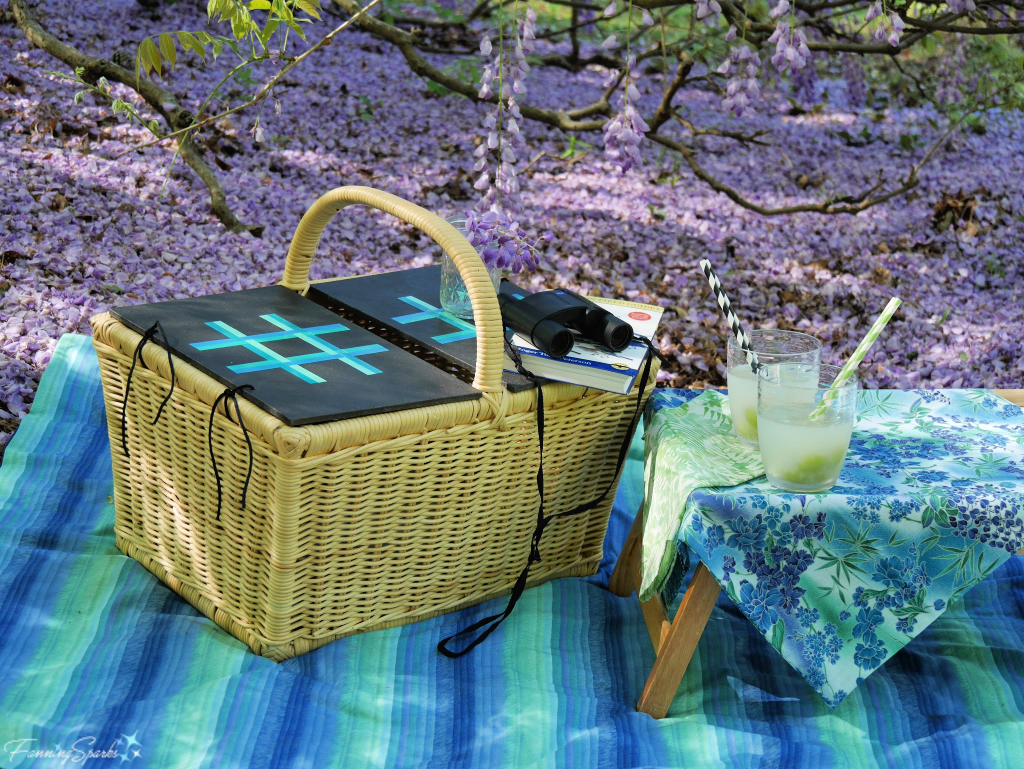 I actually found the wicker basket at a local thrift store for only $7.00 but it was missing the lids. A couple of pieces of MDF, some black spray paint and black cord solved the problem. Of course, I couldn’t just leave the covers plain black. A few strips of adhesive vinyl in a simple woven design added some punch. The new colorful grid is perfect for an impromptu game of tic-tac-toe.
I actually found the wicker basket at a local thrift store for only $7.00 but it was missing the lids. A couple of pieces of MDF, some black spray paint and black cord solved the problem. Of course, I couldn’t just leave the covers plain black. A few strips of adhesive vinyl in a simple woven design added some punch. The new colorful grid is perfect for an impromptu game of tic-tac-toe.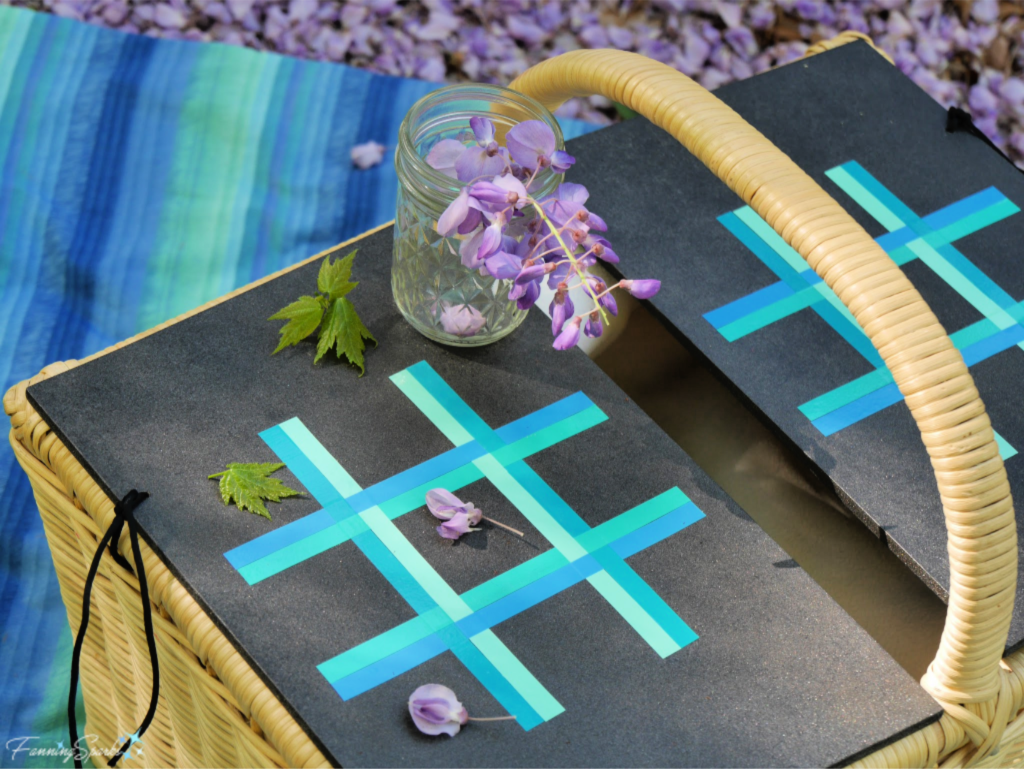 Staging this picnic was a great photography challenge. In fact, it was so much fun I may have to do it again!
Staging this picnic was a great photography challenge. In fact, it was so much fun I may have to do it again!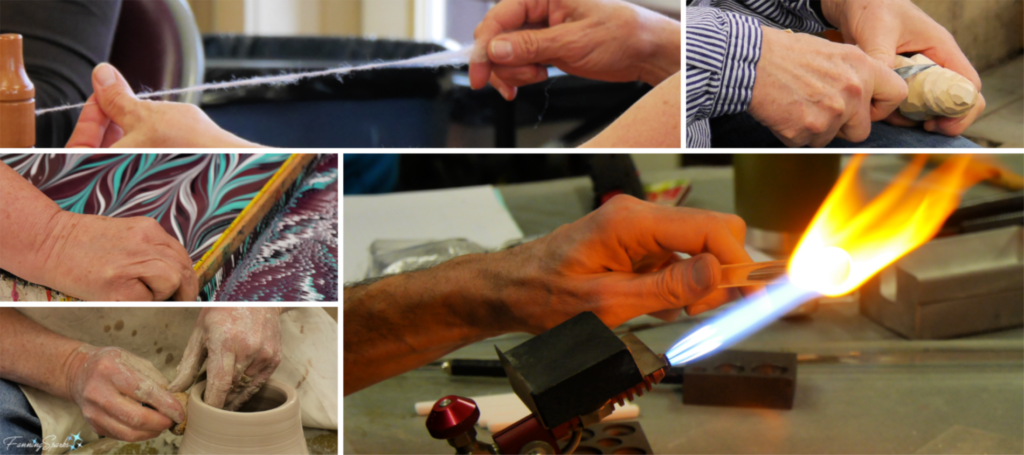
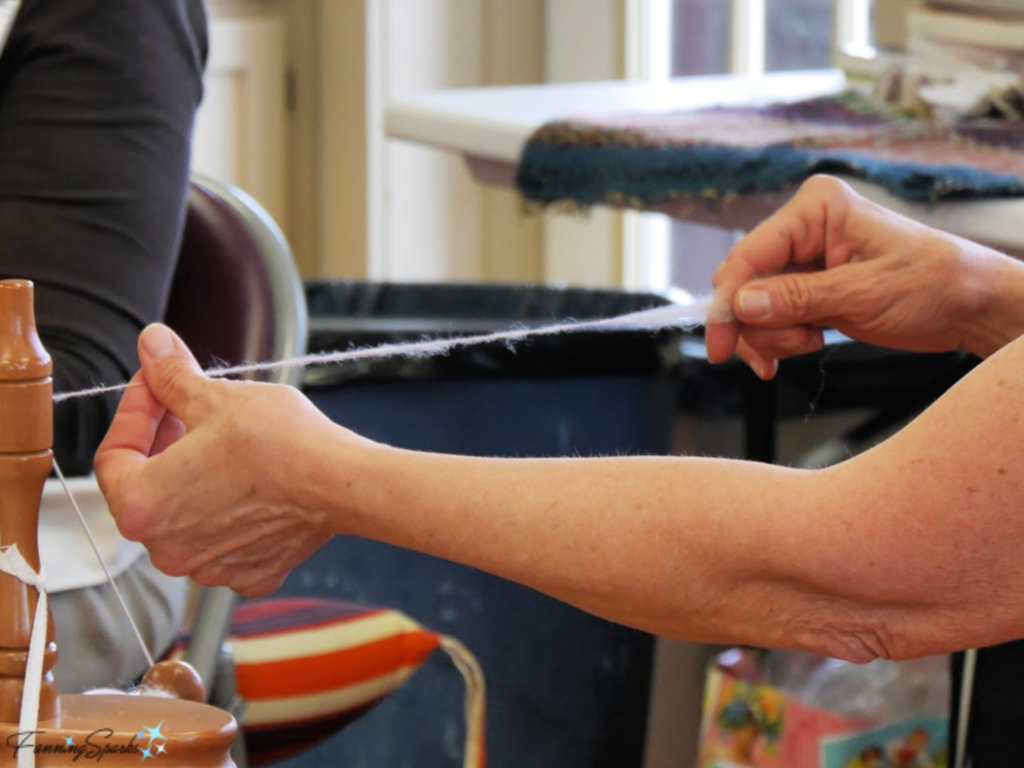 In
In 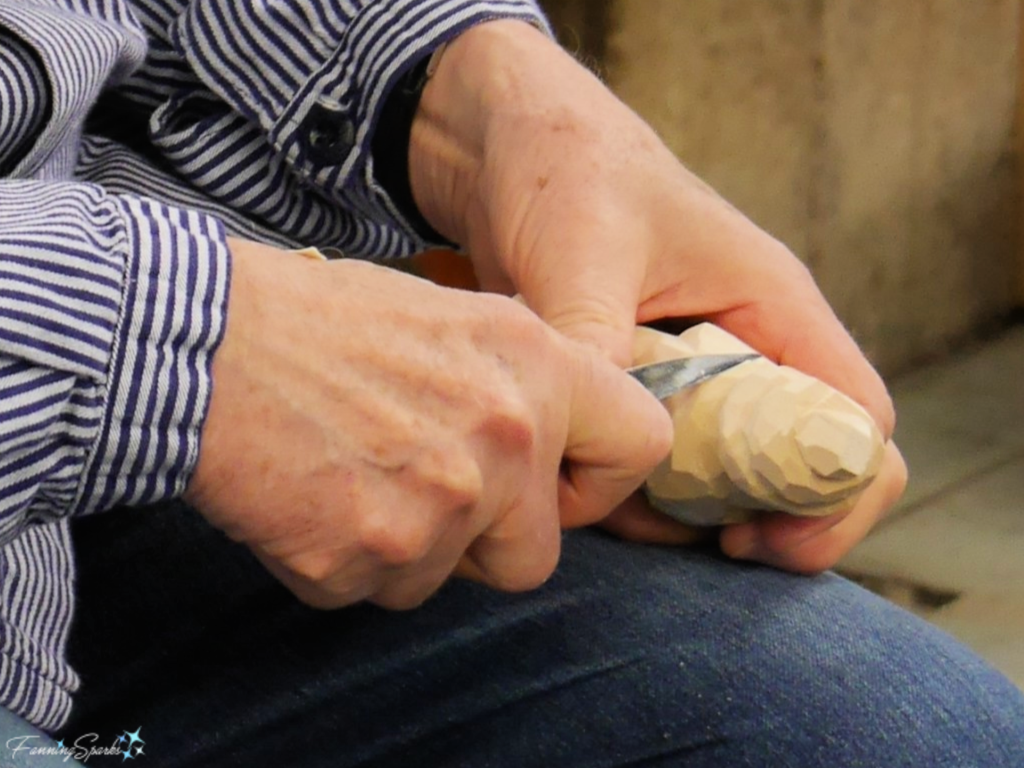 In
In  I didn’t post about every class I attended although I enjoyed them all. I participated in a week-long class on glassblowing with Alex Greenwood and Tony Prince. Here Tony demonstrates flamework.
I didn’t post about every class I attended although I enjoyed them all. I participated in a week-long class on glassblowing with Alex Greenwood and Tony Prince. Here Tony demonstrates flamework. Weekend classes on Basketry, Inkle Weaving and Portrait Photography were also informative and great fun.
Weekend classes on Basketry, Inkle Weaving and Portrait Photography were also informative and great fun.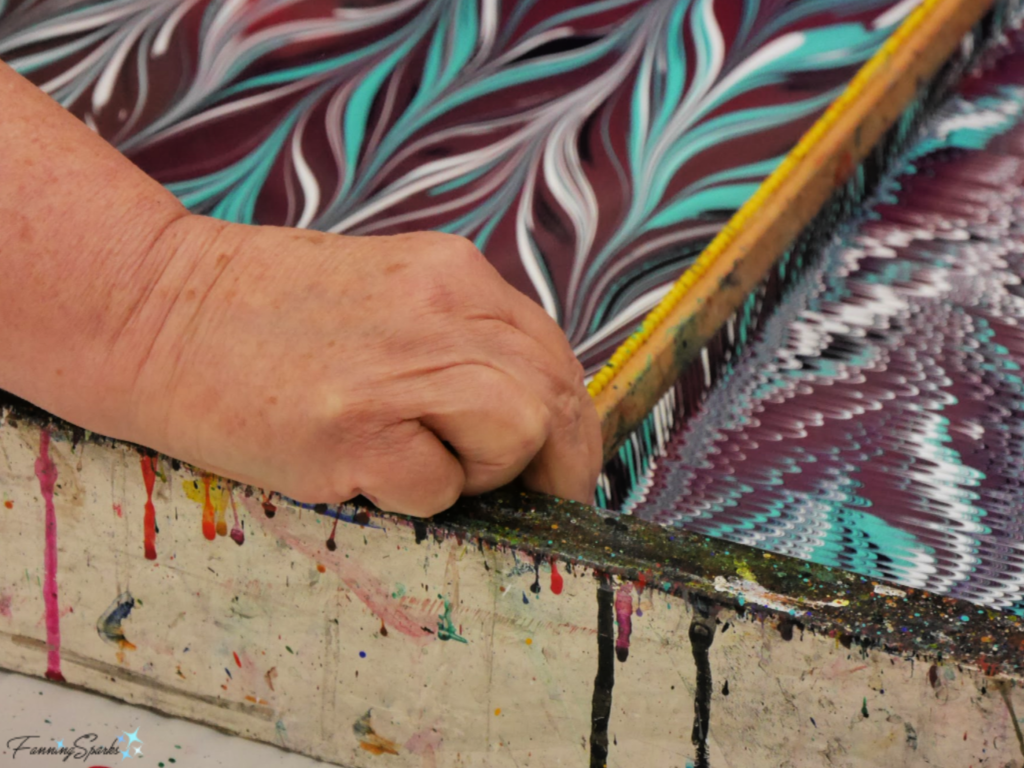 Vasanto demonstrated felt making.
Vasanto demonstrated felt making.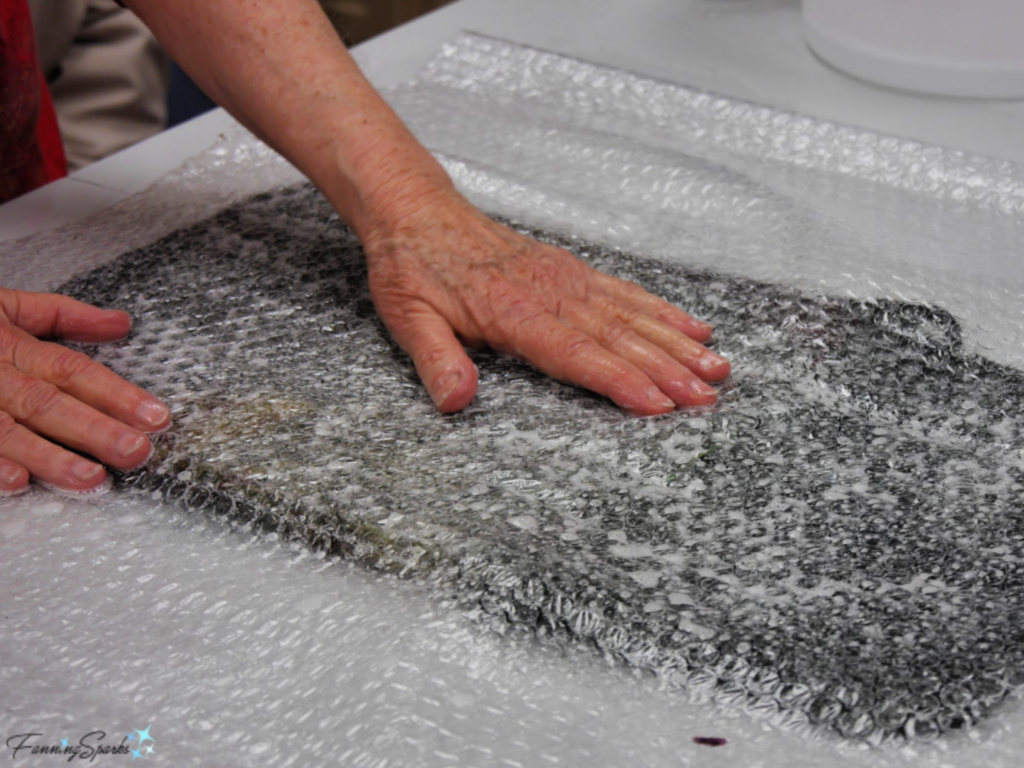 A blacksmithing demo was hosted by Paul Garrett who is the Resident Artist for Blacksmithing.
A blacksmithing demo was hosted by Paul Garrett who is the Resident Artist for Blacksmithing.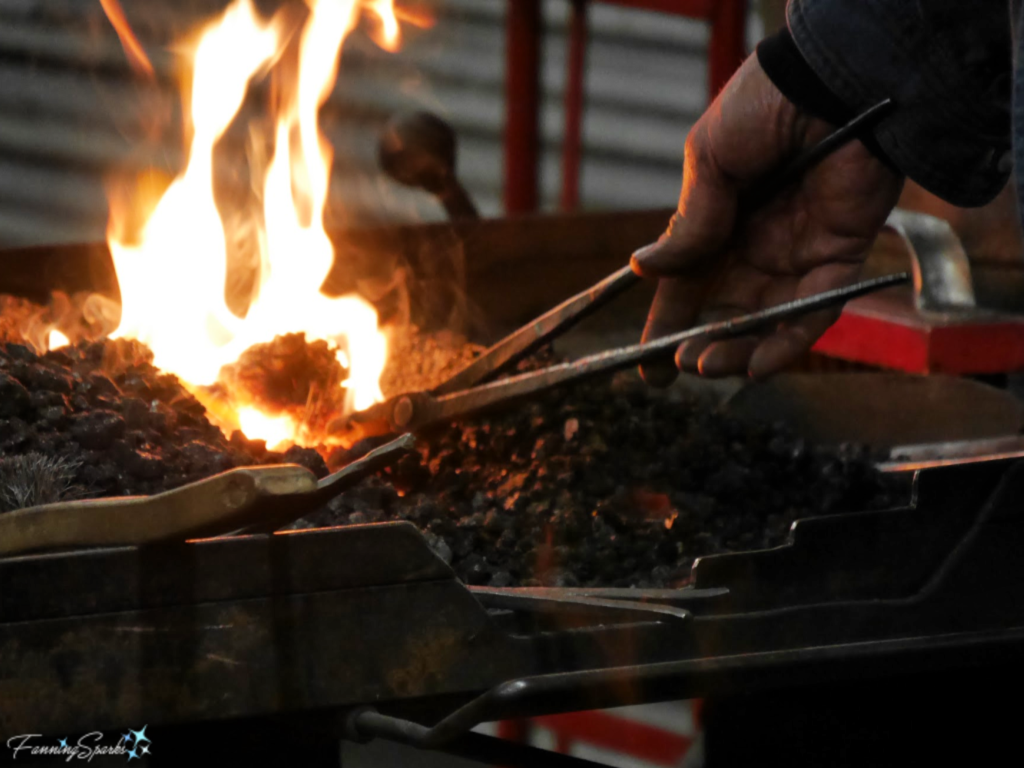 Marlow Gates demonstrated broom making.
Marlow Gates demonstrated broom making.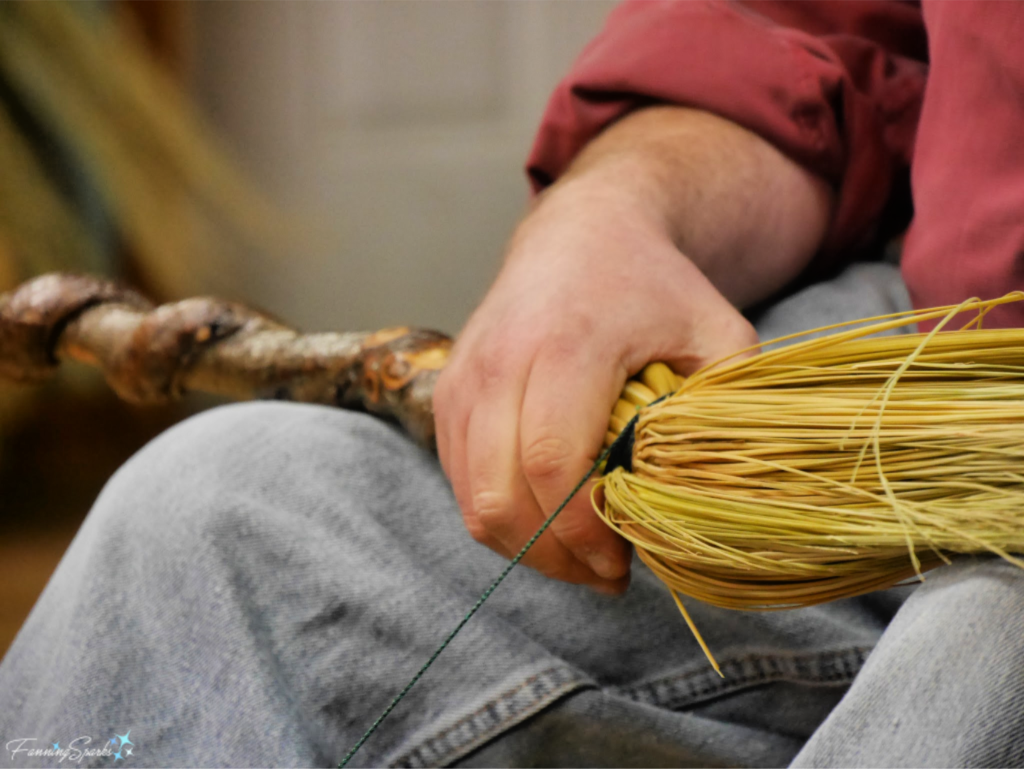 This is merely a sampling of what the Folk School has to offer. For instance, I haven’t mentioned the music and dance program but it is very popular and offers a wide variety of classes.
This is merely a sampling of what the Folk School has to offer. For instance, I haven’t mentioned the music and dance program but it is very popular and offers a wide variety of classes.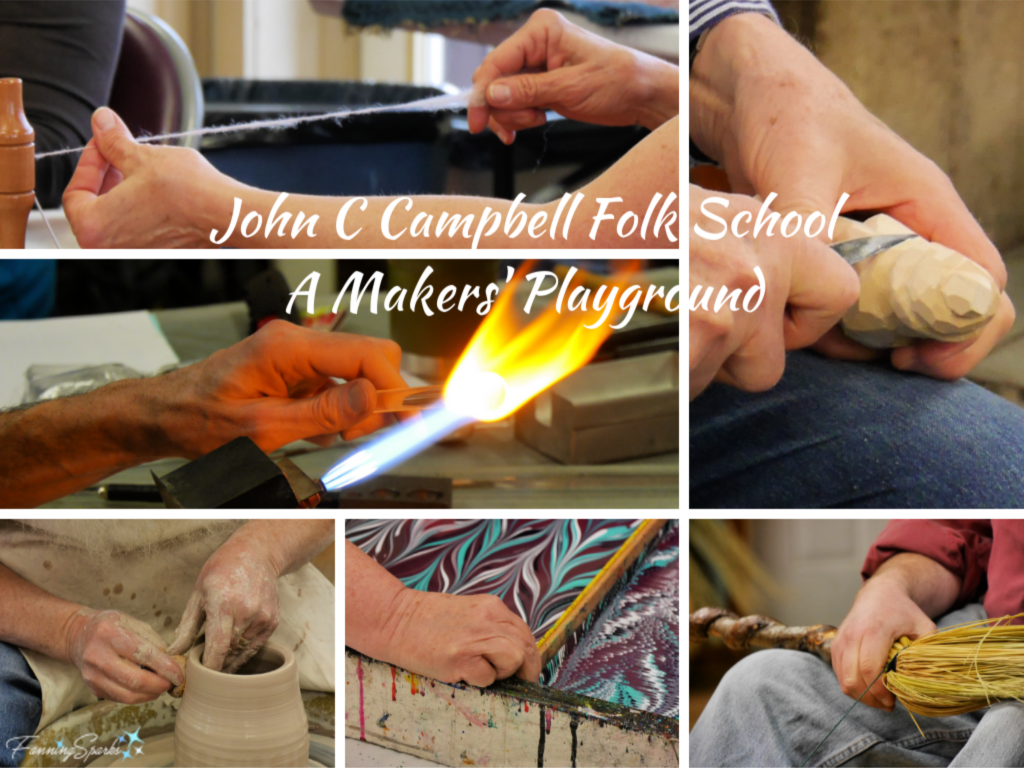

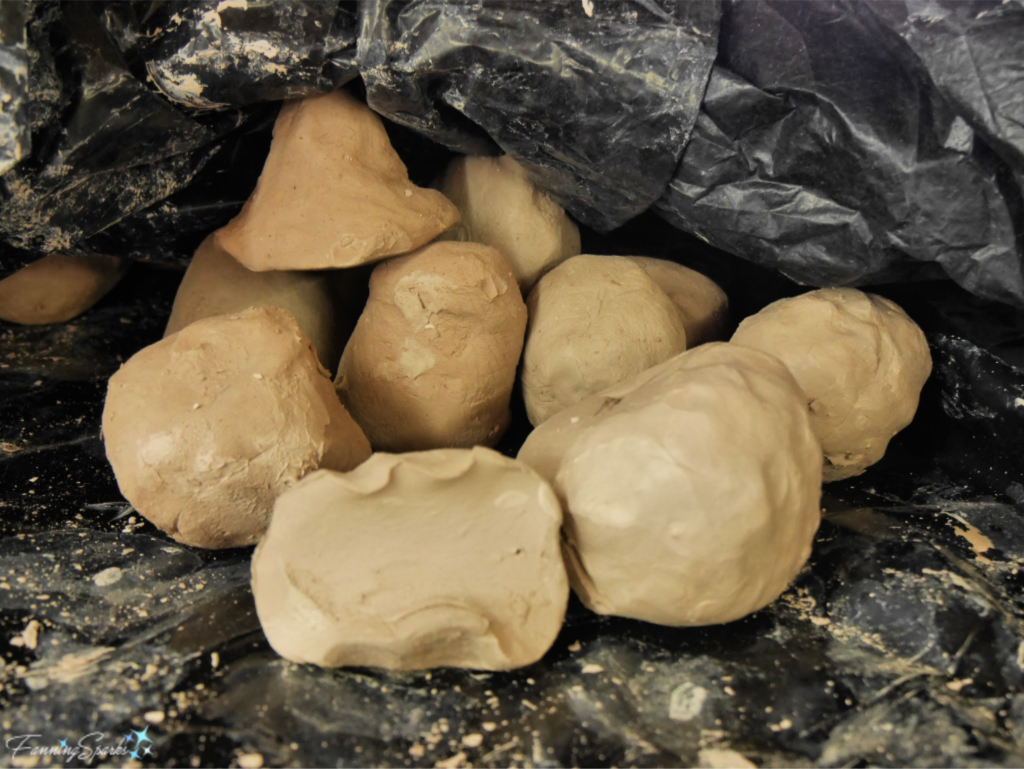 On Monday morning, instructors, Steve Fielding and Mike Lalonde, started with an information-packed demonstration. We learned about the potter’s wheel‒to set the direction and control the speed. We learned the importance of body position and posture at the wheel. Here’s a photo of my working station.
On Monday morning, instructors, Steve Fielding and Mike Lalonde, started with an information-packed demonstration. We learned about the potter’s wheel‒to set the direction and control the speed. We learned the importance of body position and posture at the wheel. Here’s a photo of my working station.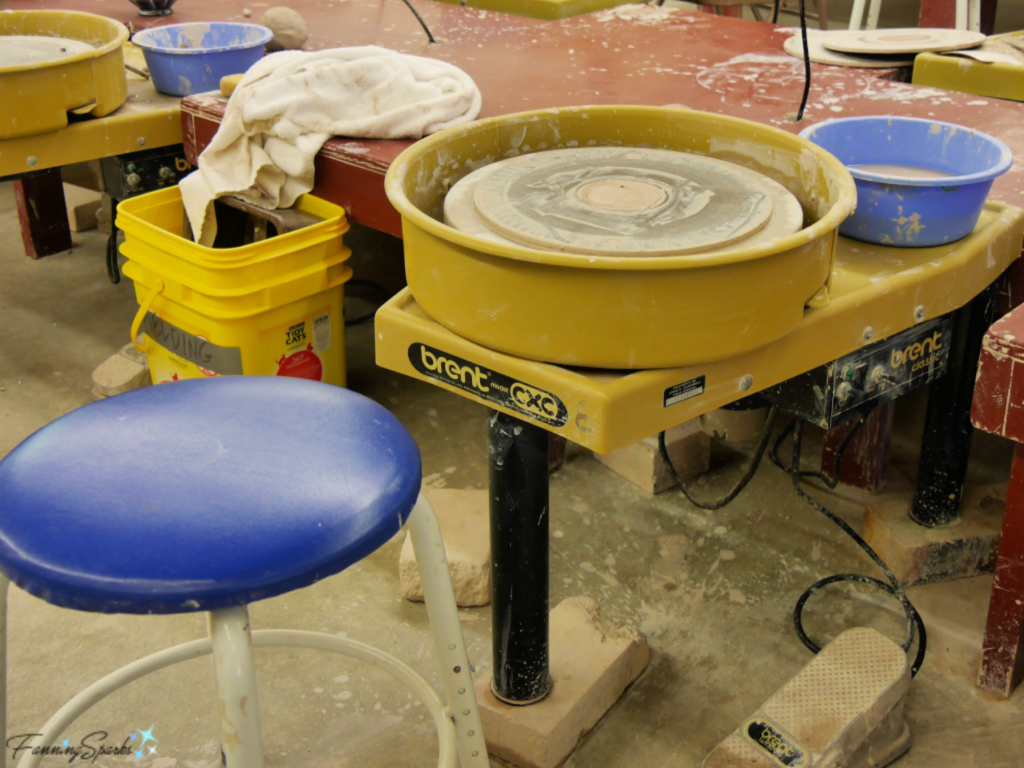 We learned about bats, which are the removable platforms on top of the wheel head, and other pieces of equipment.
We learned about bats, which are the removable platforms on top of the wheel head, and other pieces of equipment.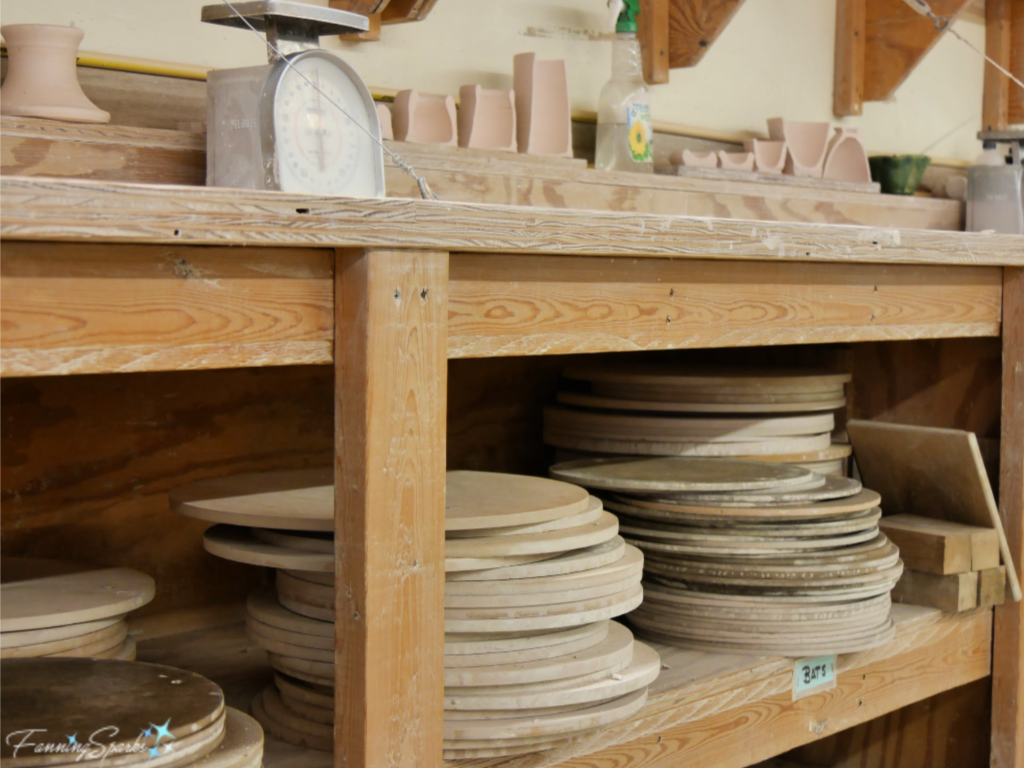 We learned about applying water to lubricate the clay without getting it too wet. Then we watched the essential steps to center, open and pull the clay. This is Steve demonstrating how to center.
We learned about applying water to lubricate the clay without getting it too wet. Then we watched the essential steps to center, open and pull the clay. This is Steve demonstrating how to center.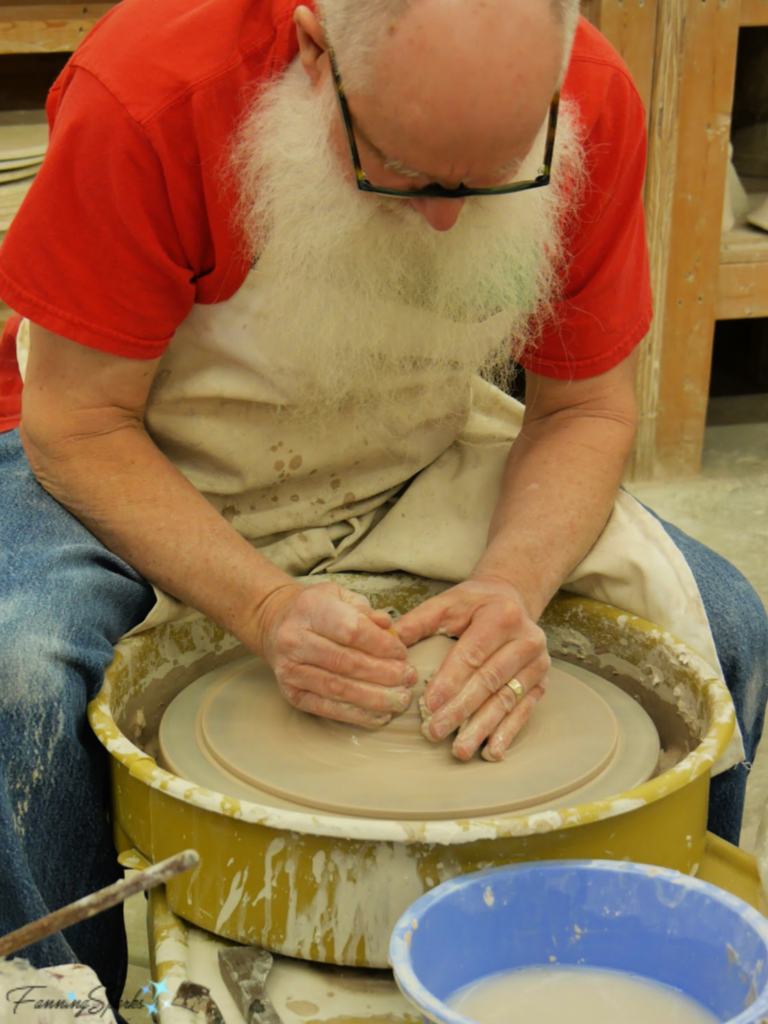
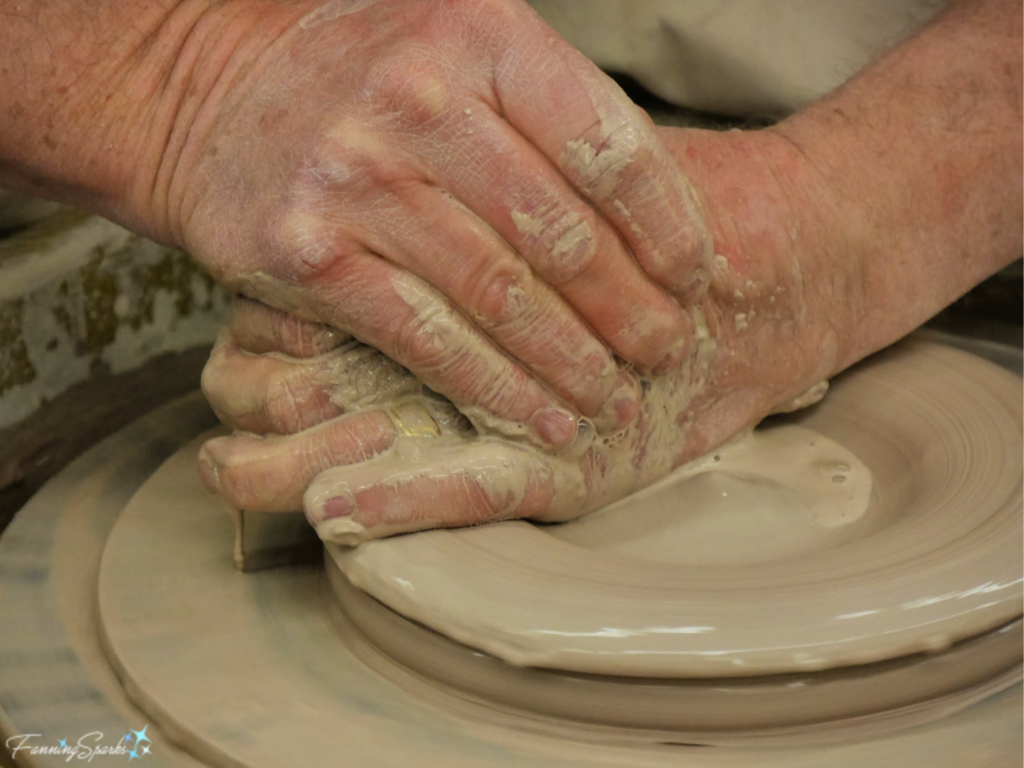 After opening, he demonstrates how to pull. “Center, Open, Pull” quickly became our mantra.
After opening, he demonstrates how to pull. “Center, Open, Pull” quickly became our mantra.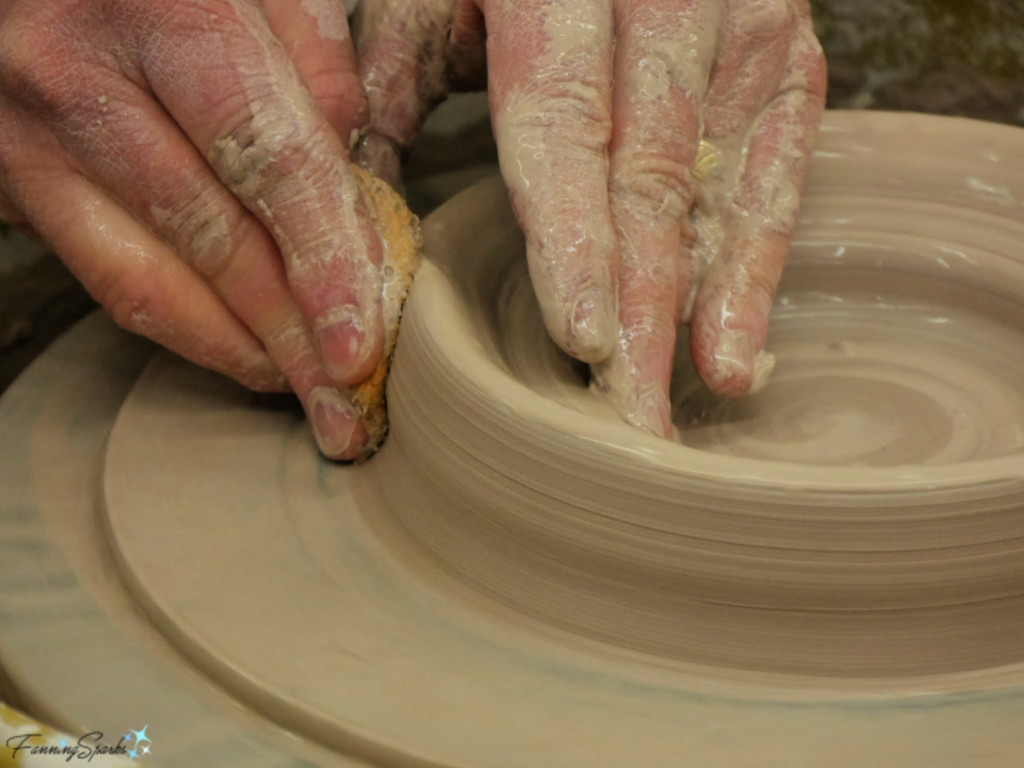 We learned about checking the thickness, compressing the rim, shaping, and various other steps. Here Steve refines the shape of his piece.
We learned about checking the thickness, compressing the rim, shaping, and various other steps. Here Steve refines the shape of his piece.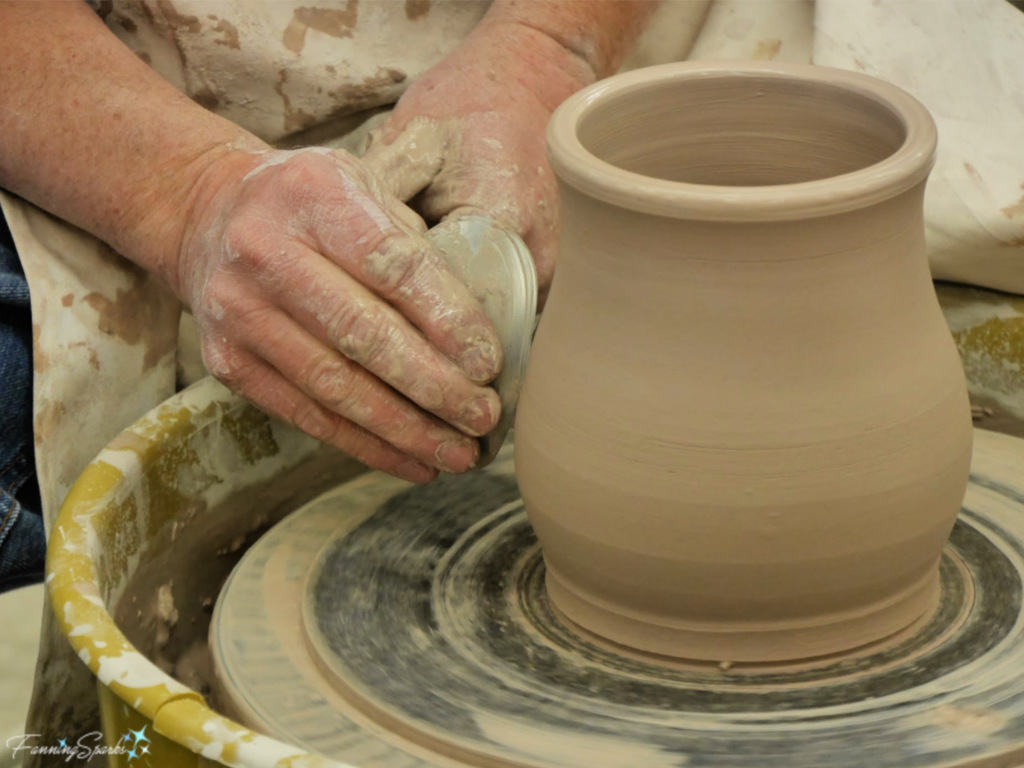 We learned about trimming the bottom edge and the importance of a “BOLD undercut” (an instruction delivered with such force that none of us will ever forget it!).
We learned about trimming the bottom edge and the importance of a “BOLD undercut” (an instruction delivered with such force that none of us will ever forget it!).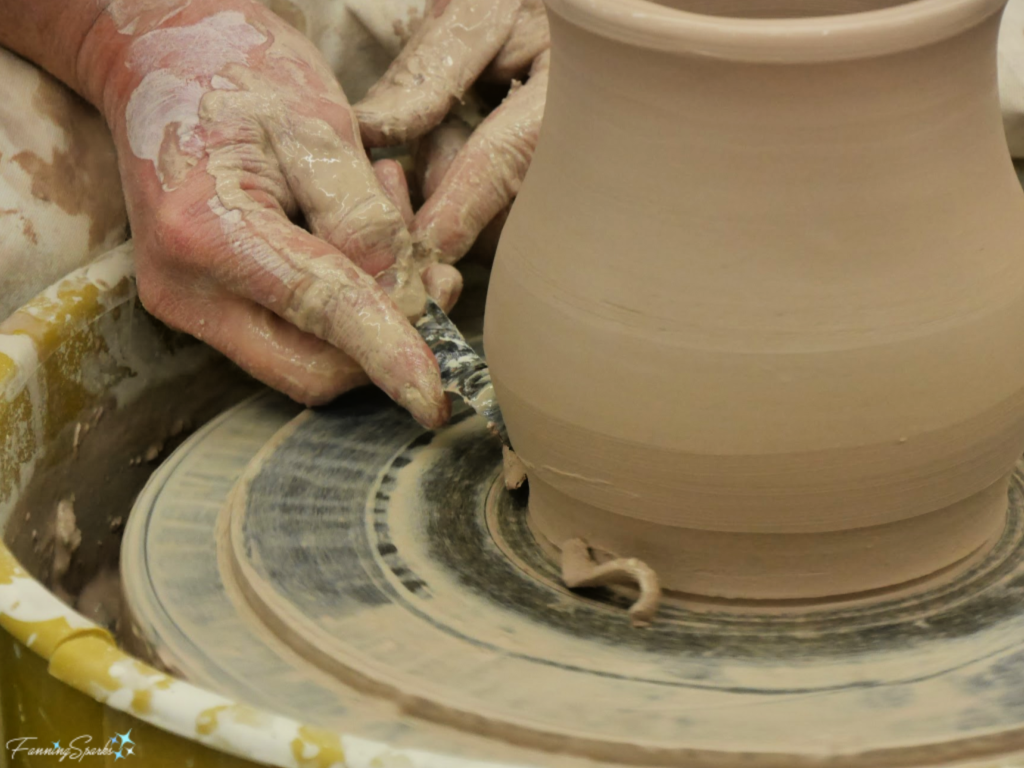 Then it was our turn to give it a try. And try and try and try. Vince Pitelka puts it this way in his book Clay A Studio Handbook: “When learning to throw, always sit down at the wheel with at least a dozen balls of clay. You must abandon the preciousness of the individual piece. Starting with only a few balls of clay encourages an unconscious determination to make every piece a success and thus an unproductive tendency to overwork the clay. Keep working on a piece if things are going well, but the instant it starts to go bad, scrap it and start another. You will accelerate the learning curve and accomplish far more.” I wish I’d realized this from the get-go. Abandoning the preciousness of each piece is not something that comes naturally to me! But I did become very familiar with the Scrap Clay bucket where we abandoned our precious pieces.
Then it was our turn to give it a try. And try and try and try. Vince Pitelka puts it this way in his book Clay A Studio Handbook: “When learning to throw, always sit down at the wheel with at least a dozen balls of clay. You must abandon the preciousness of the individual piece. Starting with only a few balls of clay encourages an unconscious determination to make every piece a success and thus an unproductive tendency to overwork the clay. Keep working on a piece if things are going well, but the instant it starts to go bad, scrap it and start another. You will accelerate the learning curve and accomplish far more.” I wish I’d realized this from the get-go. Abandoning the preciousness of each piece is not something that comes naturally to me! But I did become very familiar with the Scrap Clay bucket where we abandoned our precious pieces.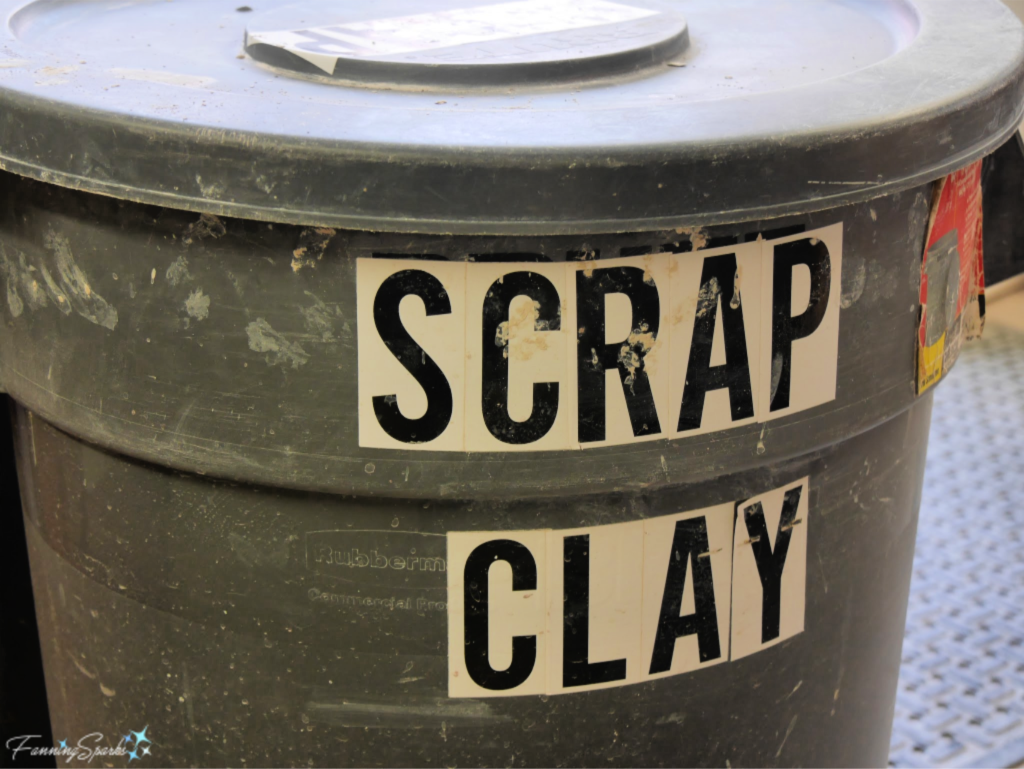 The instructors told us about the importance of a slow and steady touch‒to always apply and release pressure on the clay slowly. But experience was the best teacher on this point. Clay is very responsive which means you have total control over how the clay is shaped but it also means one, small misplaced movement can quickly ruin the piece. Developing the right touch can only be accomplished through a great deal of practice.
The instructors told us about the importance of a slow and steady touch‒to always apply and release pressure on the clay slowly. But experience was the best teacher on this point. Clay is very responsive which means you have total control over how the clay is shaped but it also means one, small misplaced movement can quickly ruin the piece. Developing the right touch can only be accomplished through a great deal of practice.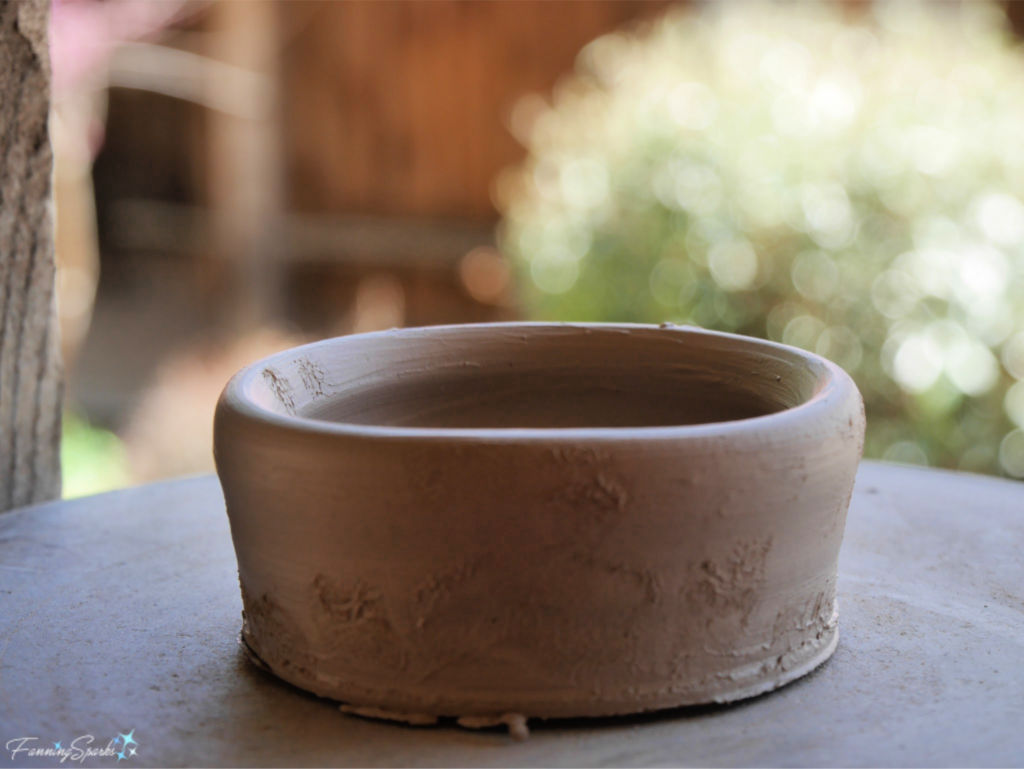 Some of the students were more experienced as evidenced by the beauty of their first pieces.
Some of the students were more experienced as evidenced by the beauty of their first pieces.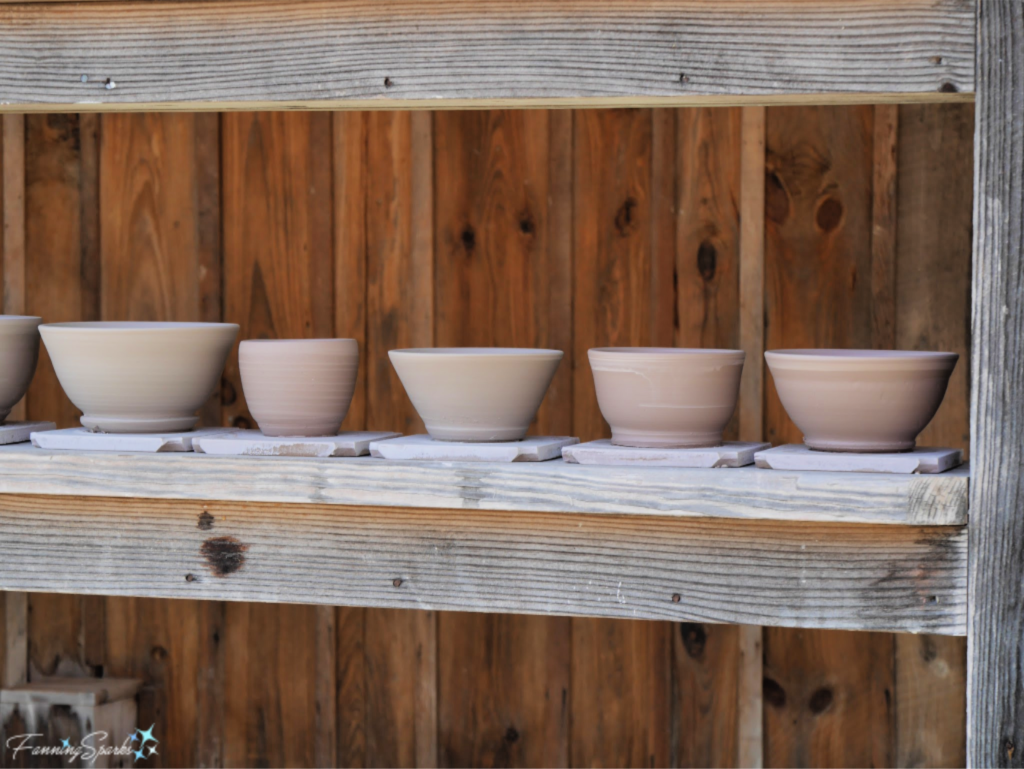 Throughout the week, we witnessed the process to center, open and pull multiple times. We learned about drying and firing clay. We learned the steps to complete at each stage from wet, leather-hard, bone-dry to bisque. We started with bowls and then progressed to cylinders and mugs. We had fun experimenting with glazes trying different colors and combinations.
Throughout the week, we witnessed the process to center, open and pull multiple times. We learned about drying and firing clay. We learned the steps to complete at each stage from wet, leather-hard, bone-dry to bisque. We started with bowls and then progressed to cylinders and mugs. We had fun experimenting with glazes trying different colors and combinations.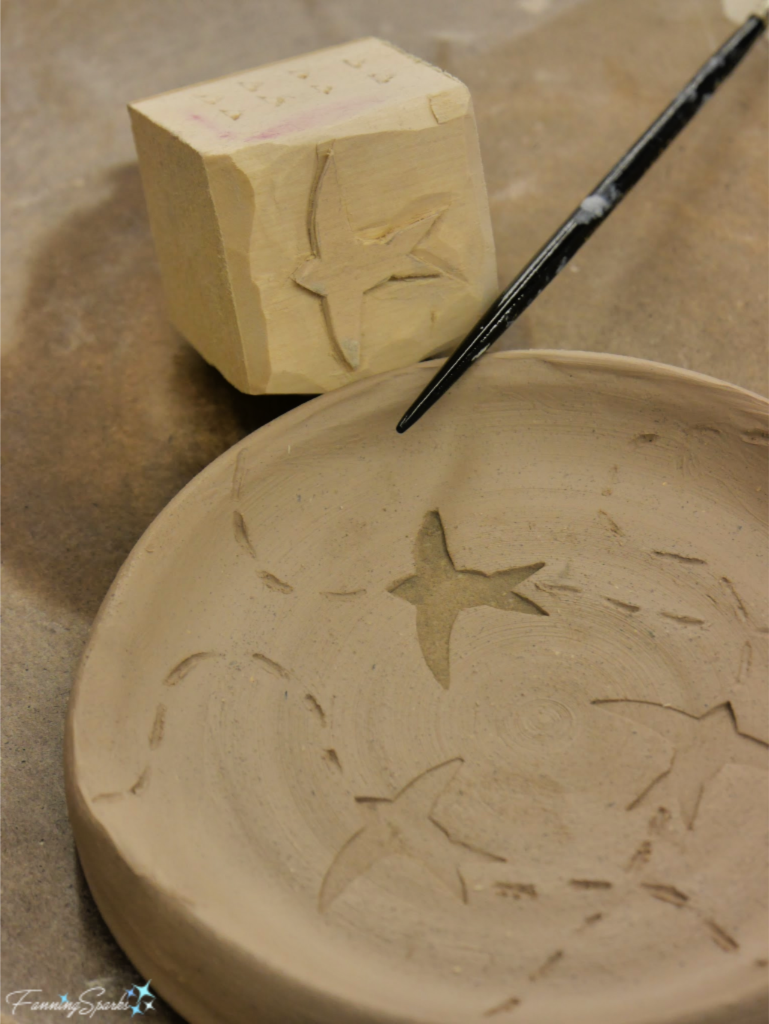
 I love this spoon rest! I love that it’s functional and serves a purpose in my daily life. But most of all, I love that it is a combination of two new skills I learned at the Folk School‒woodcarving and clay throwing. It is one of a kind and truly unique to me.
I love this spoon rest! I love that it’s functional and serves a purpose in my daily life. But most of all, I love that it is a combination of two new skills I learned at the Folk School‒woodcarving and clay throwing. It is one of a kind and truly unique to me.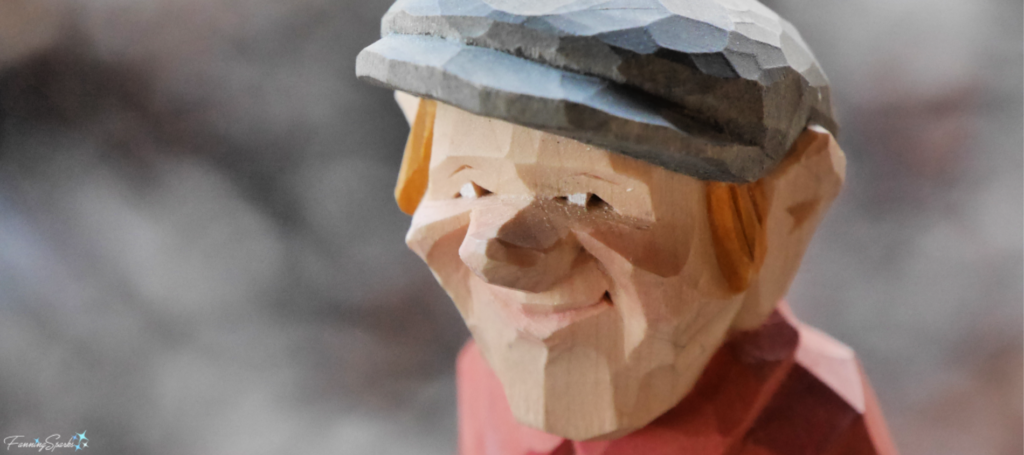
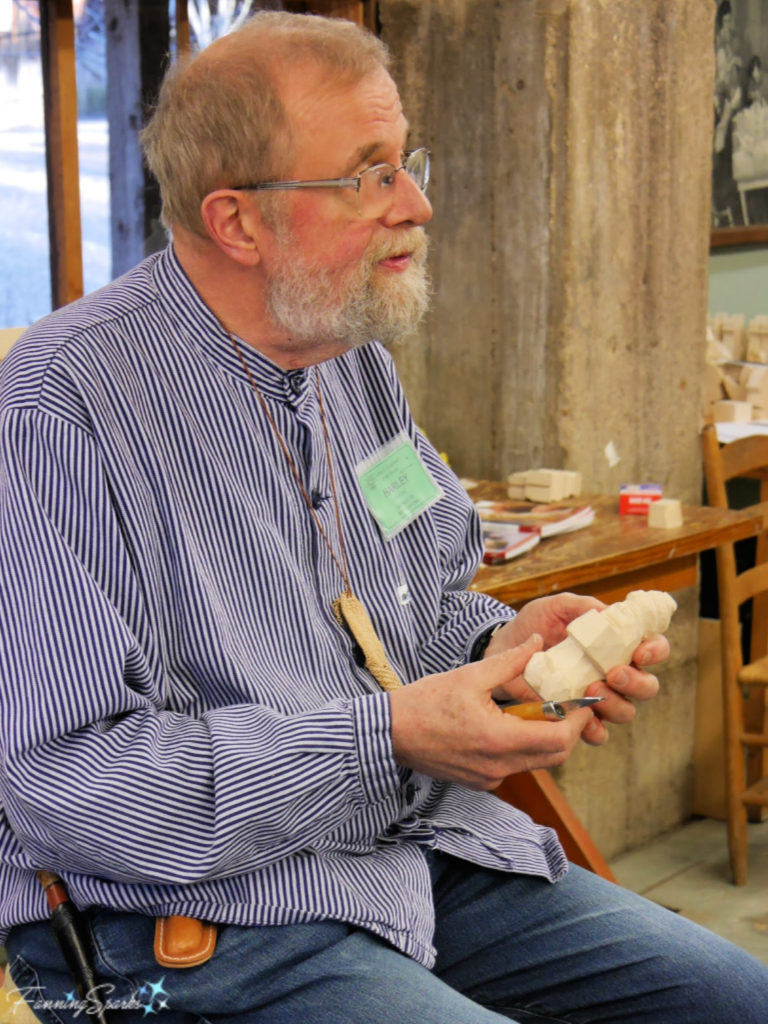
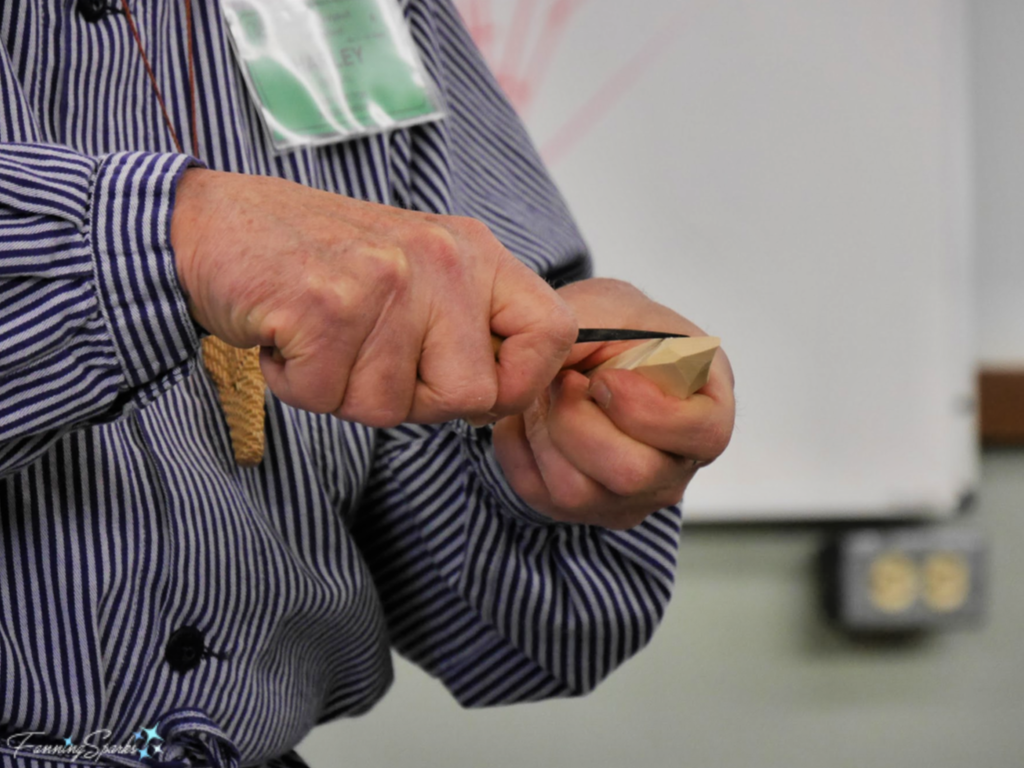 After carving the simple carrot form, we drilled a small hole at the top of the carrot with a hand drill. Here’s my carrot (bottom left) about to be drilled.
After carving the simple carrot form, we drilled a small hole at the top of the carrot with a hand drill. Here’s my carrot (bottom left) about to be drilled.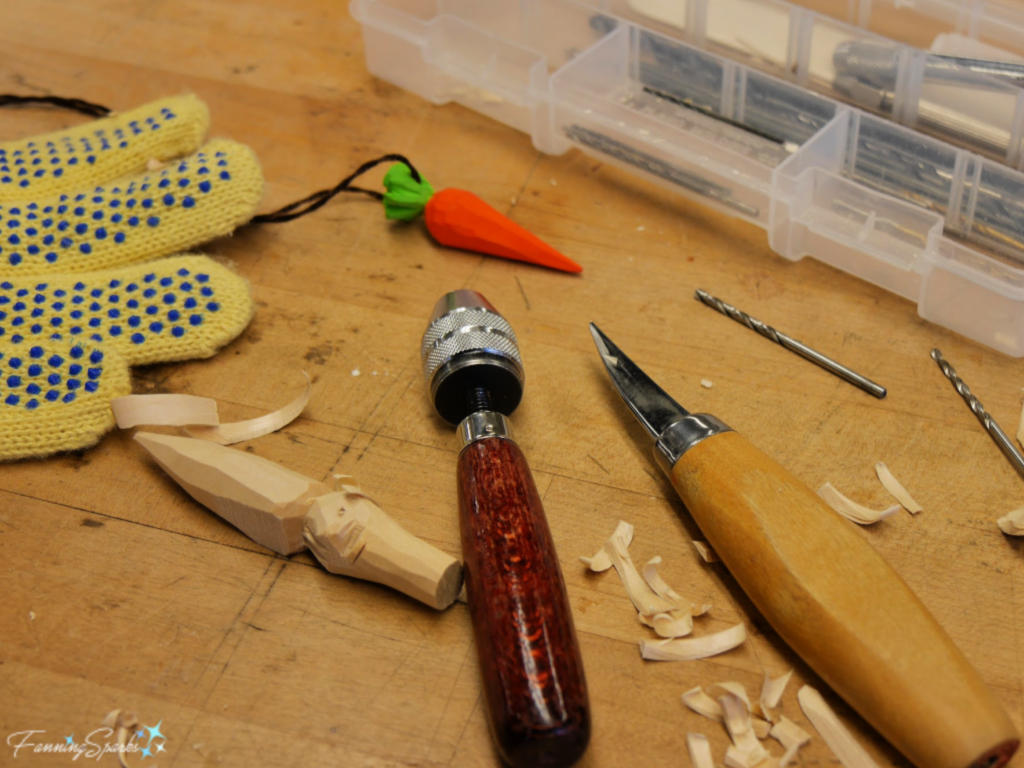 The class progressed from carrots to fish. Harley uses a fish figure to introduce the topic of wood grain and how to adjust your cutting technique according to the direction of the grain. He uses a simple phrase “Always ski downhill” as a reminder to push the knife in the same direction as the wood grain. Here is a finished fish, often referred to as the “go by”, in front of my fish carving blank.
The class progressed from carrots to fish. Harley uses a fish figure to introduce the topic of wood grain and how to adjust your cutting technique according to the direction of the grain. He uses a simple phrase “Always ski downhill” as a reminder to push the knife in the same direction as the wood grain. Here is a finished fish, often referred to as the “go by”, in front of my fish carving blank.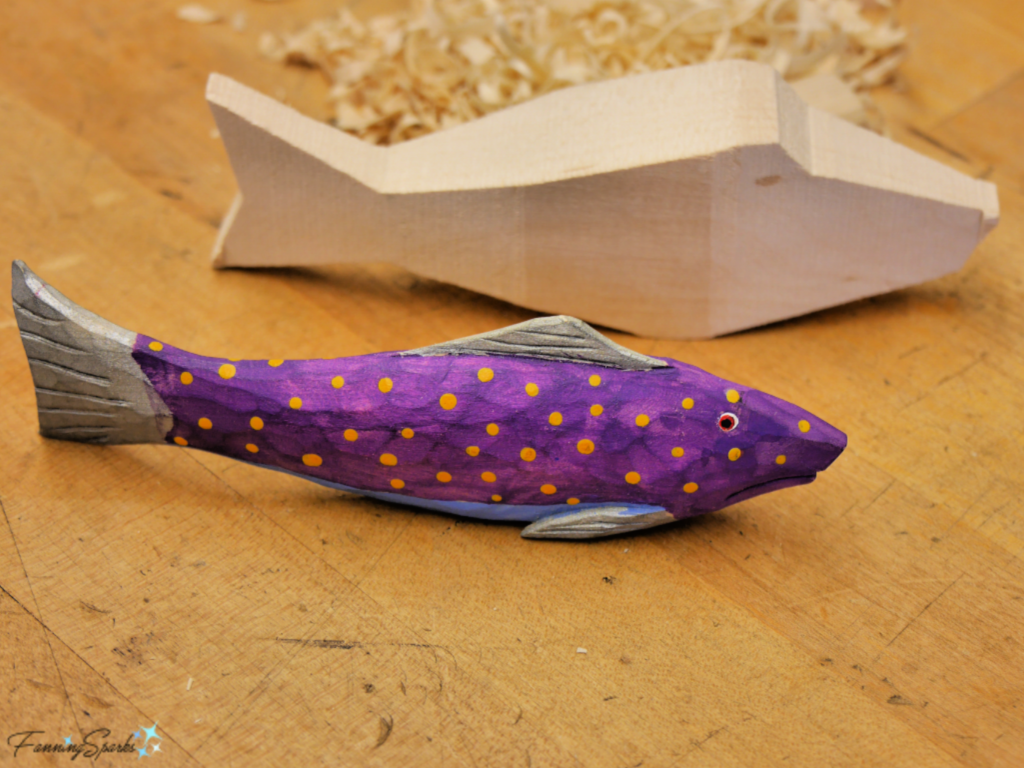 Harley brought a variety of figures and carving blanks to give the students lots of options.
Harley brought a variety of figures and carving blanks to give the students lots of options.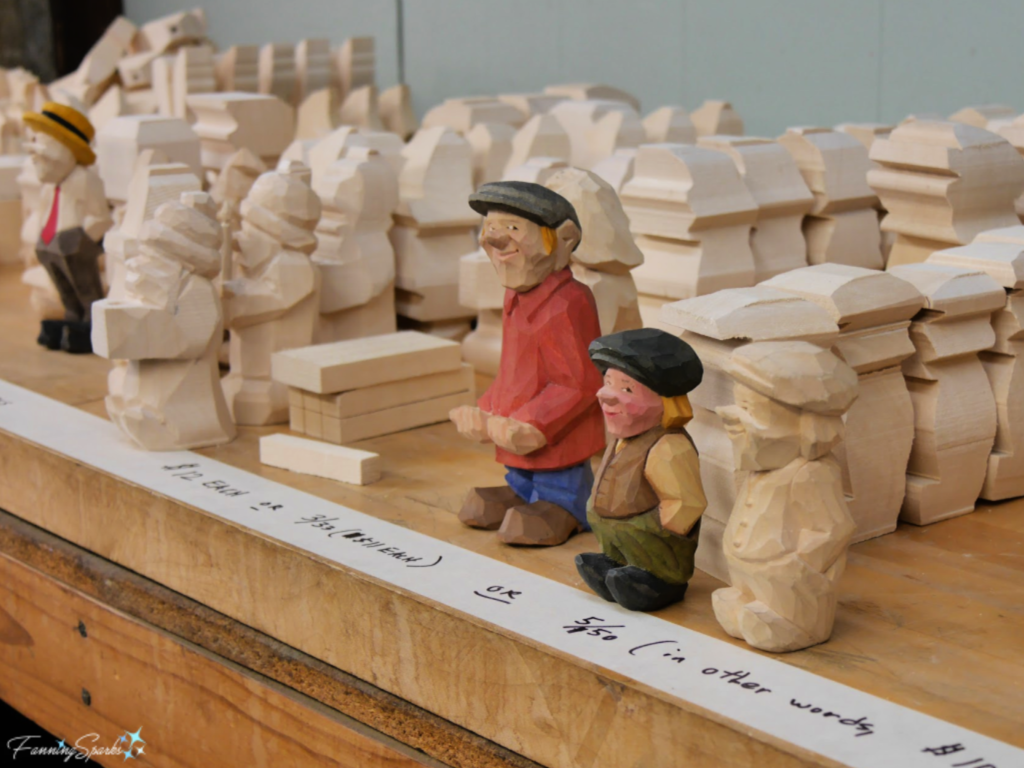 The tomte, a figure inspired by the work of painter/illustrator Jenny Nyström (1854-1946) creator of the Swedish image of the Jultomte, is one of Harley’s favorites.
The tomte, a figure inspired by the work of painter/illustrator Jenny Nyström (1854-1946) creator of the Swedish image of the Jultomte, is one of Harley’s favorites.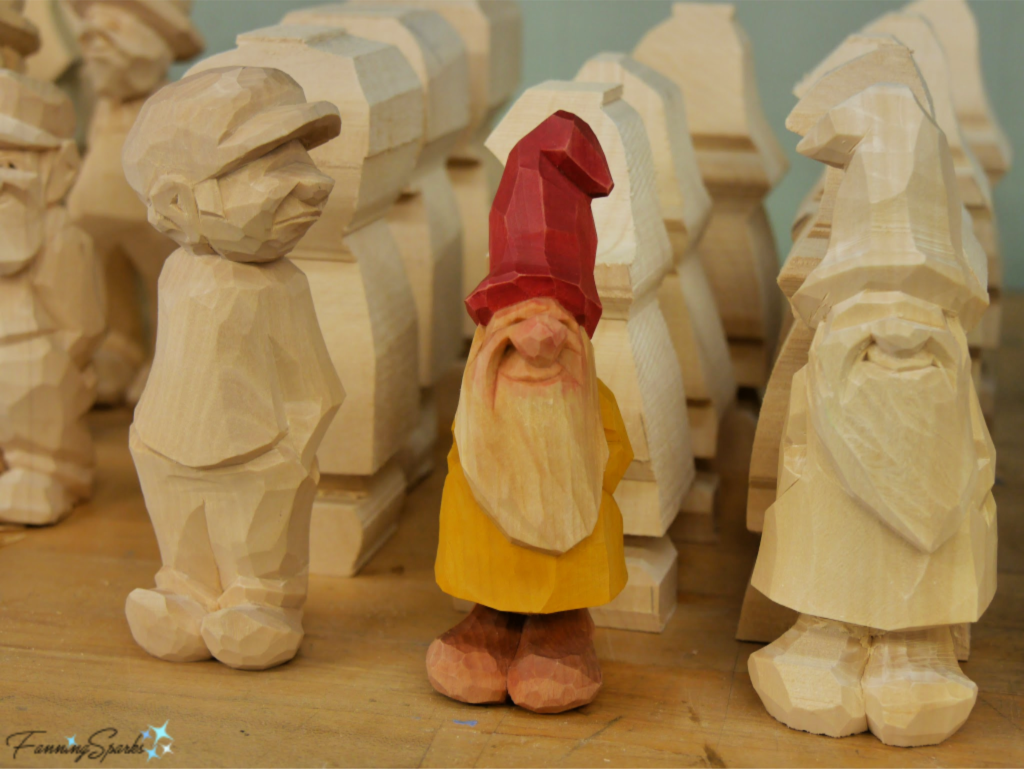 Harley emphasized the importance of a sharp knife and demonstrated knife sharpening techniques. Here he is using a series of credit card-sized Dia-sharp sharpeners from DMT (Diamond Machine Technology).
Harley emphasized the importance of a sharp knife and demonstrated knife sharpening techniques. Here he is using a series of credit card-sized Dia-sharp sharpeners from DMT (Diamond Machine Technology).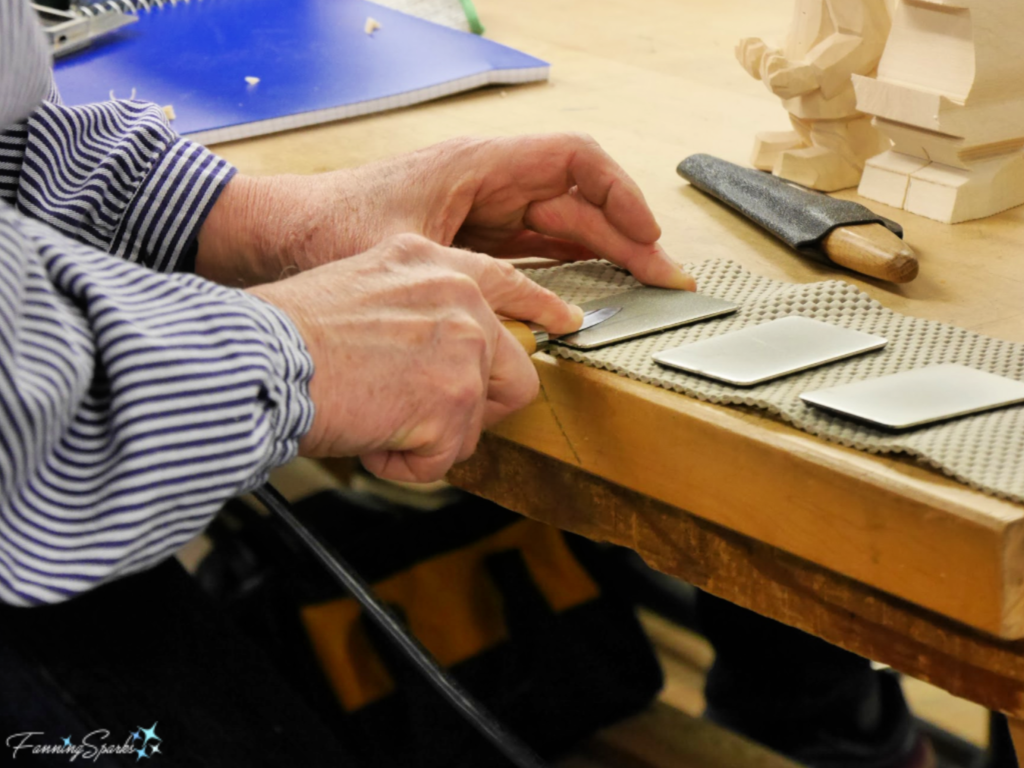 I decided to tackle a horse figure next. Here’s the go by with my carving blank.
I decided to tackle a horse figure next. Here’s the go by with my carving blank.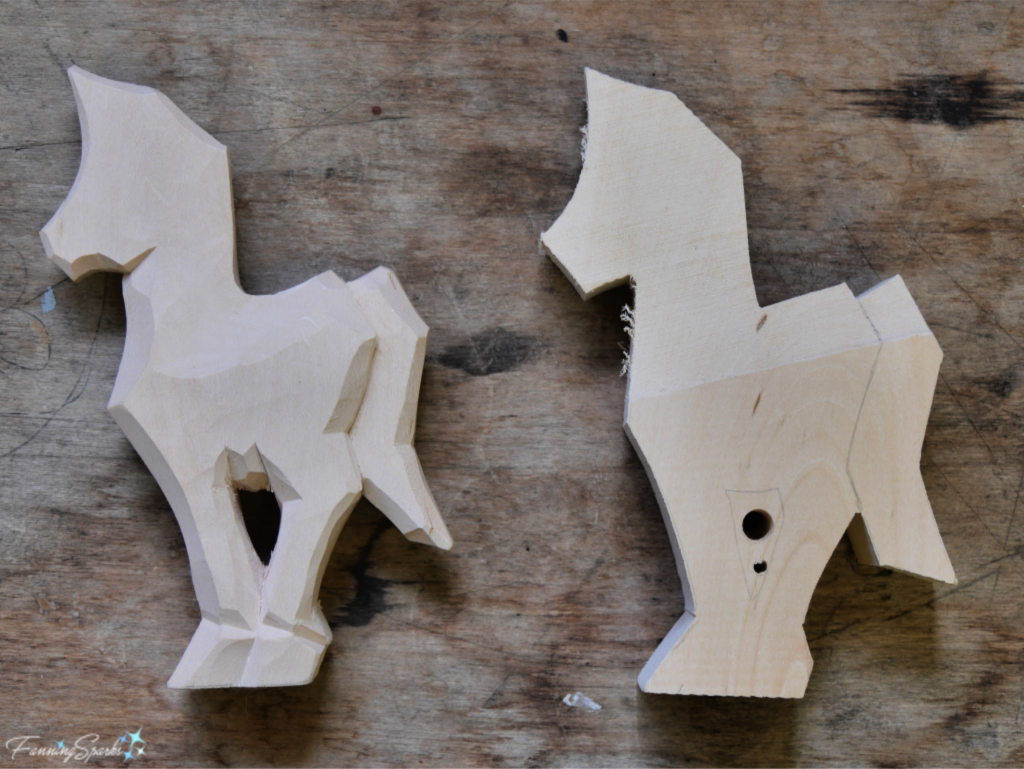 This horse figure lends itself to the flat-plane style. I was pleased with my progress.
This horse figure lends itself to the flat-plane style. I was pleased with my progress. Then for my biggest carving challenge to date, I decided to take on a figure of a man designed to hold a sign. This is the go by model carved by Harley.
Then for my biggest carving challenge to date, I decided to take on a figure of a man designed to hold a sign. This is the go by model carved by Harley.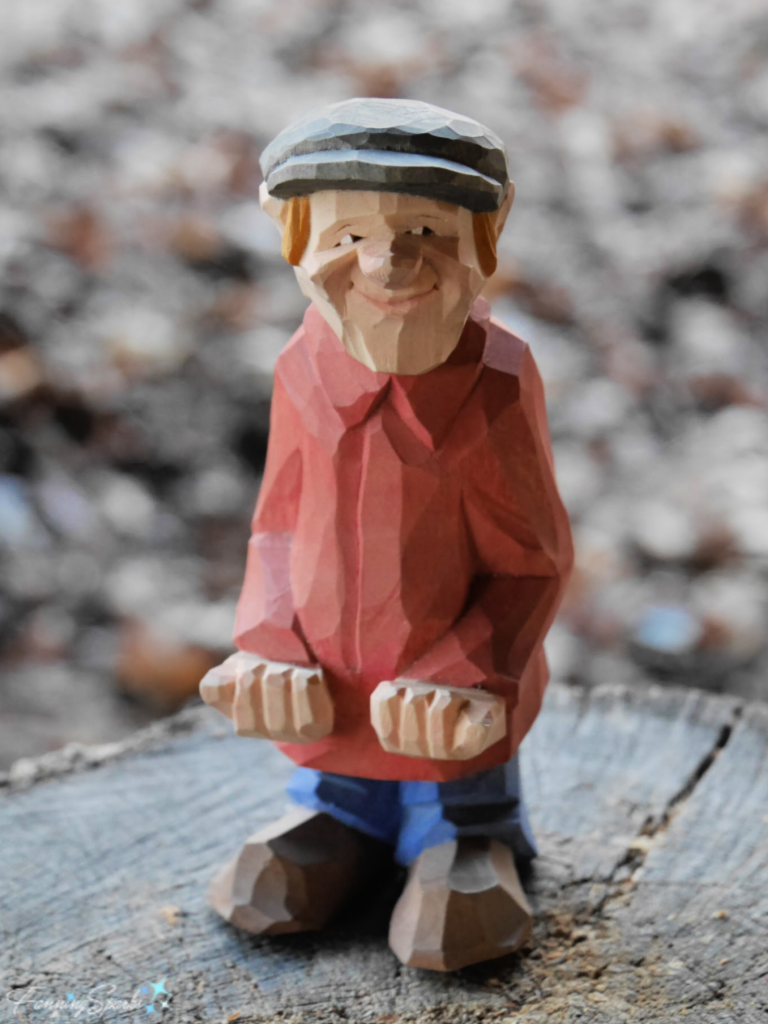 Here’s my carving blank with the first section carved out around his left shoe.
Here’s my carving blank with the first section carved out around his left shoe.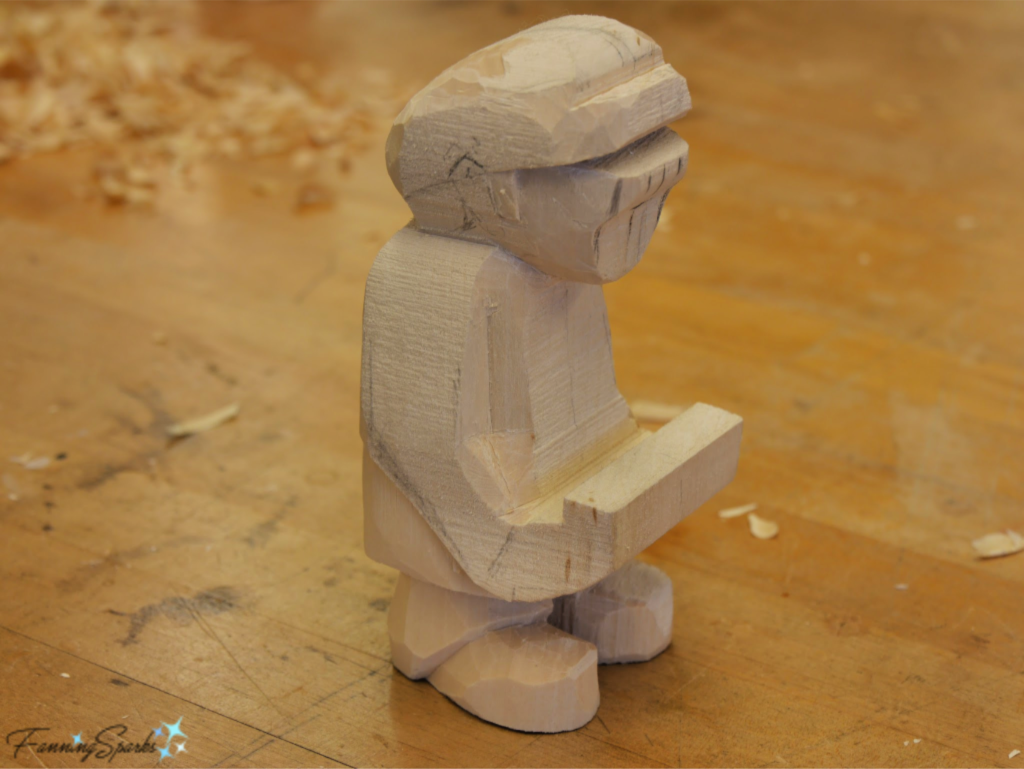 I worked on this figure for several days with lots of assistance from Harley and Frank. In the below photo, I’m about to tackle the face. One lesson I learned is the importance of marking your cuts. A pencil is indeed a critical tool for woodcarving.
I worked on this figure for several days with lots of assistance from Harley and Frank. In the below photo, I’m about to tackle the face. One lesson I learned is the importance of marking your cuts. A pencil is indeed a critical tool for woodcarving.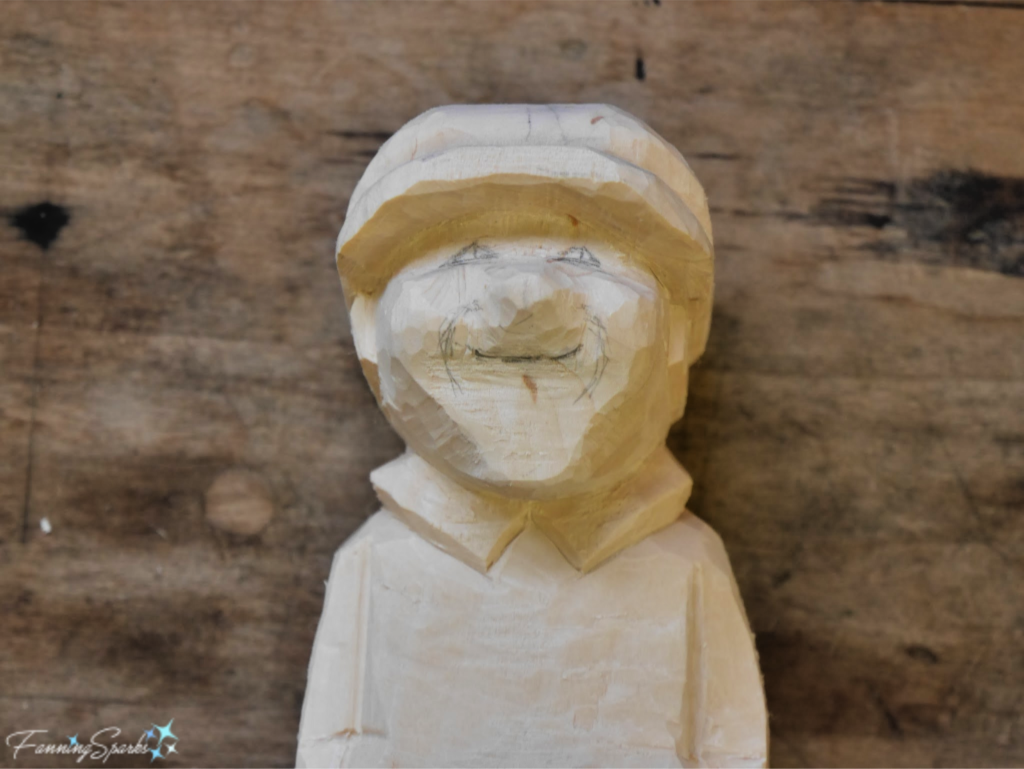 Although I decided to leave my figure natural, we learned how to paint and finish our pieces. Harley thins water-based acrylics to paint his carvings.
Although I decided to leave my figure natural, we learned how to paint and finish our pieces. Harley thins water-based acrylics to paint his carvings.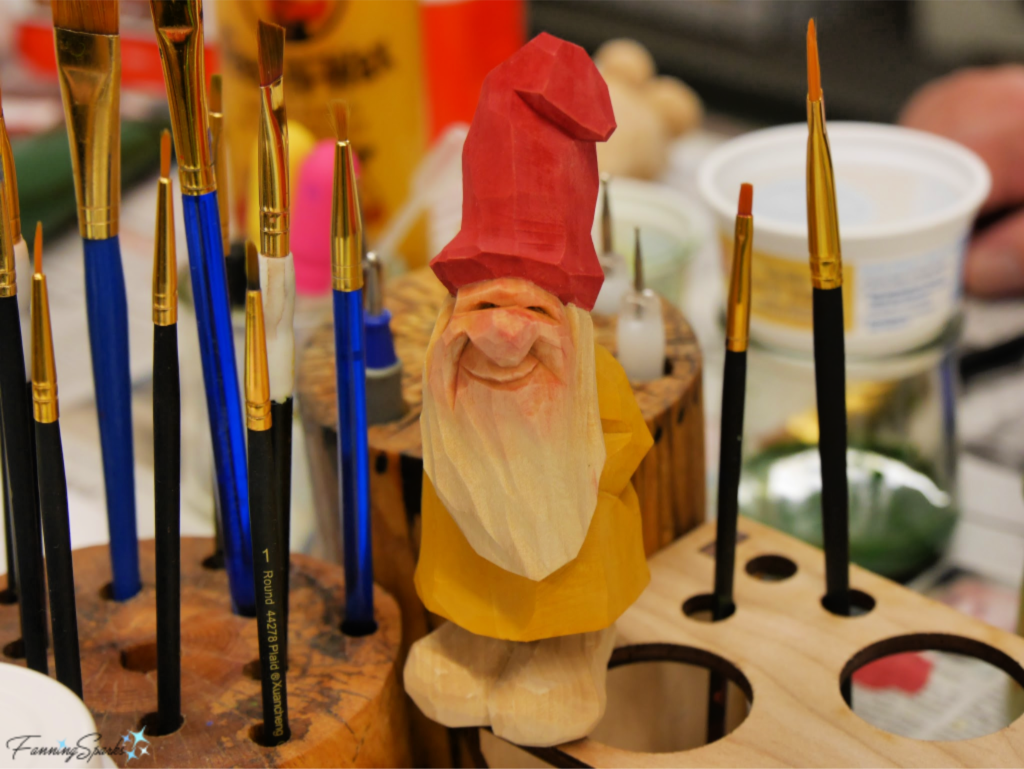 Then he finishes them with a matte finish wax such as Watco Satin Wax.
Then he finishes them with a matte finish wax such as Watco Satin Wax.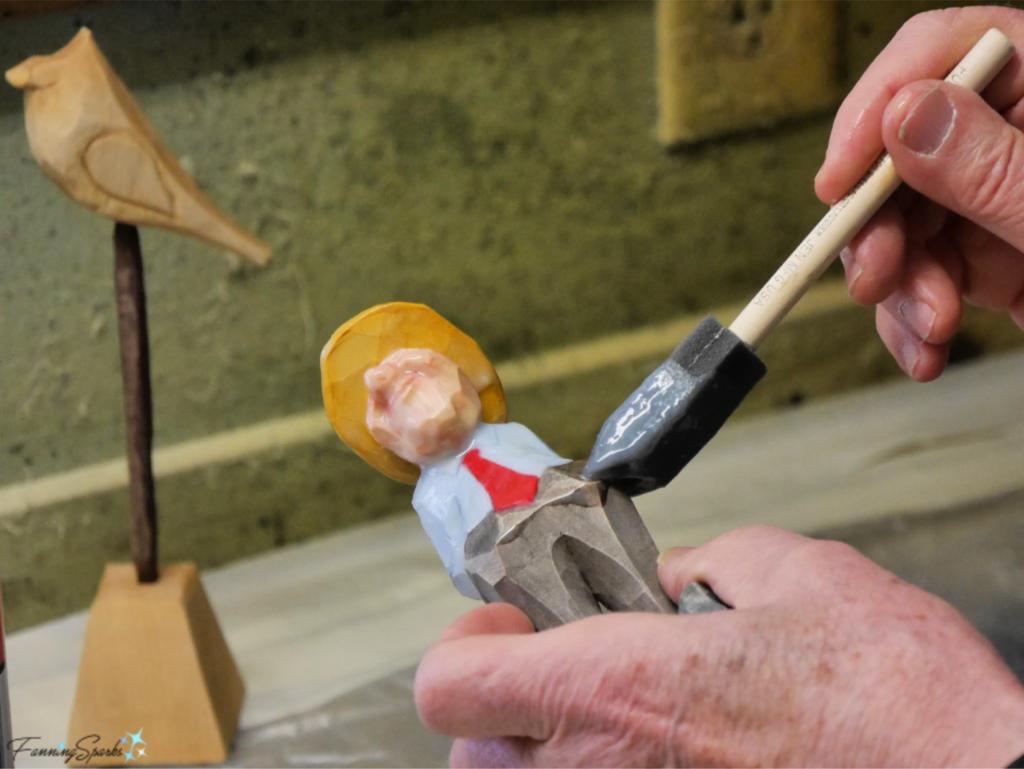 I chose the sign holder figure because it’s functional. But as I looked for the perfect spot to place it in my home, I realized it’s so much more than just a sign holder-it’s a delightful reminder of the joy of creating and wonderful days spent carving with Harley, Frank and my new carving friends.
I chose the sign holder figure because it’s functional. But as I looked for the perfect spot to place it in my home, I realized it’s so much more than just a sign holder-it’s a delightful reminder of the joy of creating and wonderful days spent carving with Harley, Frank and my new carving friends.
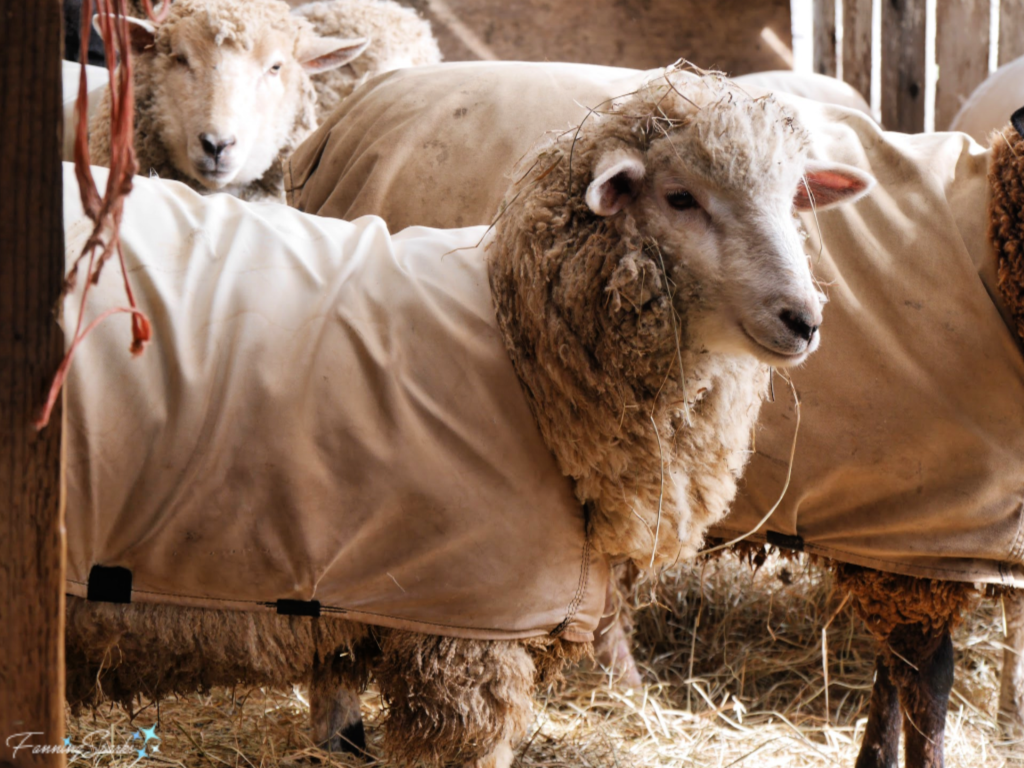 We capped off the week with a visit to Martha’s sheep farm. There we saw two different herds of sheep, the Corriedales and Romneys; and the Shetland sheep. Seeing the sheep “up close and personal” definitely brought the information to life.
We capped off the week with a visit to Martha’s sheep farm. There we saw two different herds of sheep, the Corriedales and Romneys; and the Shetland sheep. Seeing the sheep “up close and personal” definitely brought the information to life.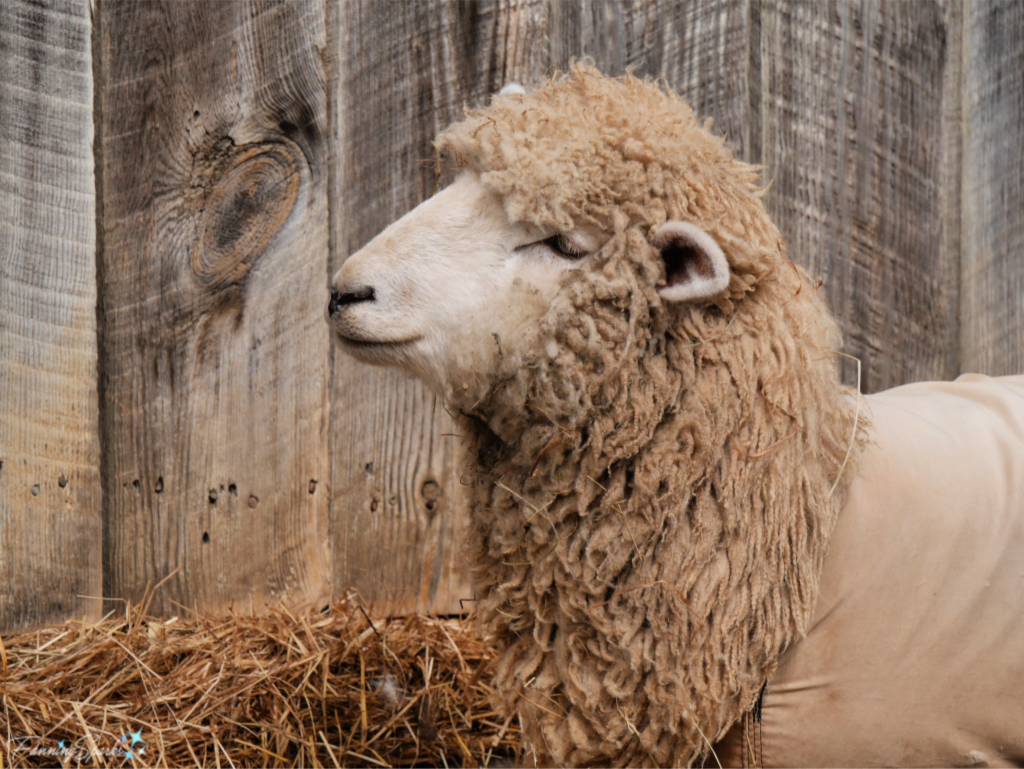
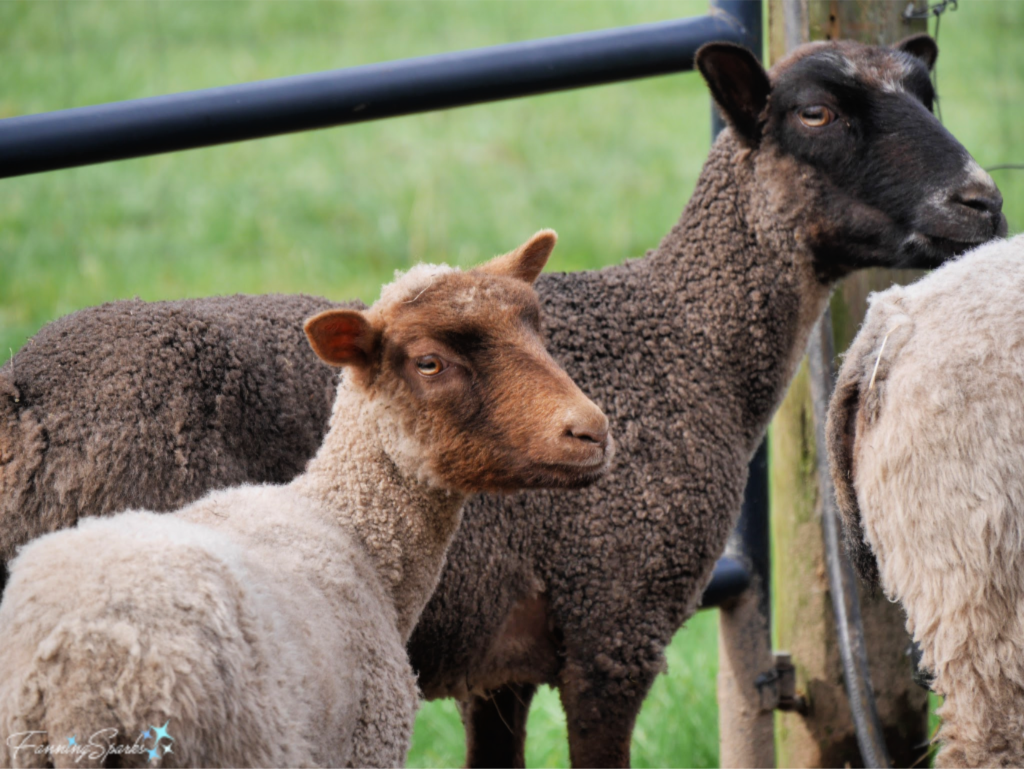
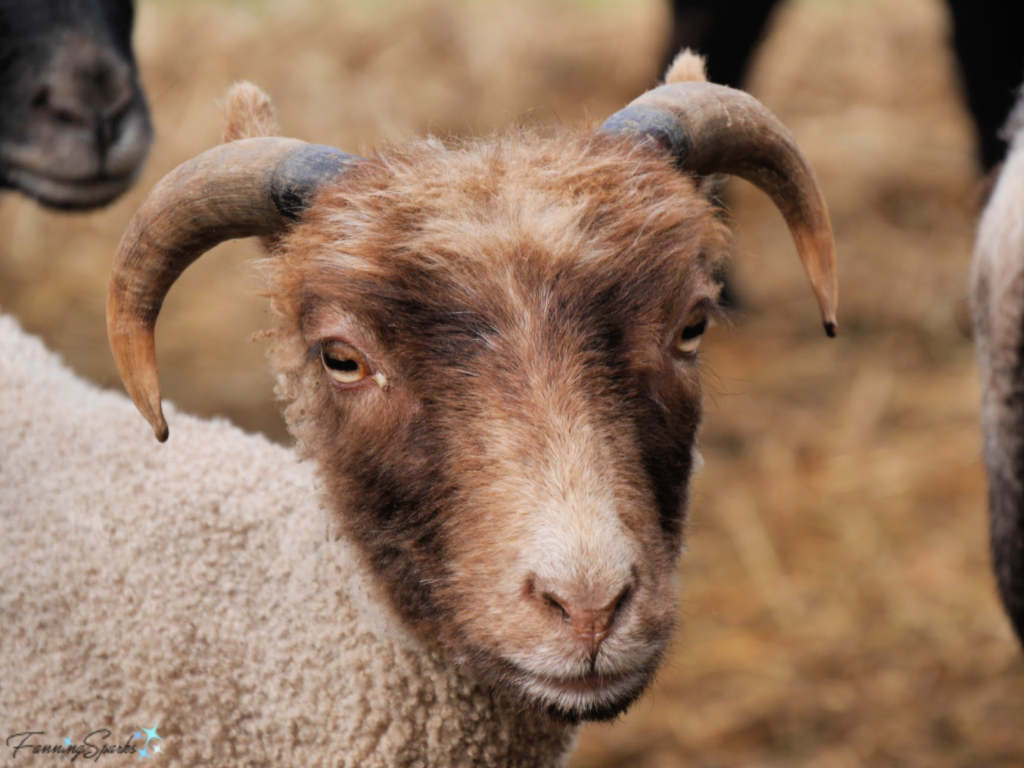
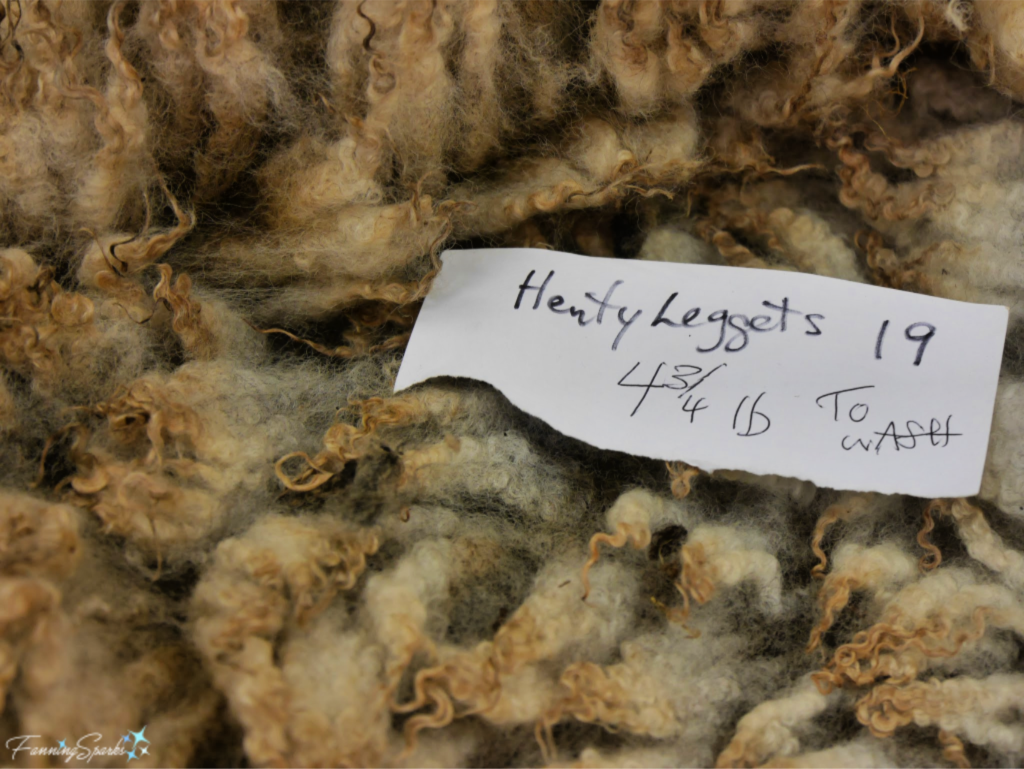 We washed the fleece and hung it to dry overnight.
We washed the fleece and hung it to dry overnight.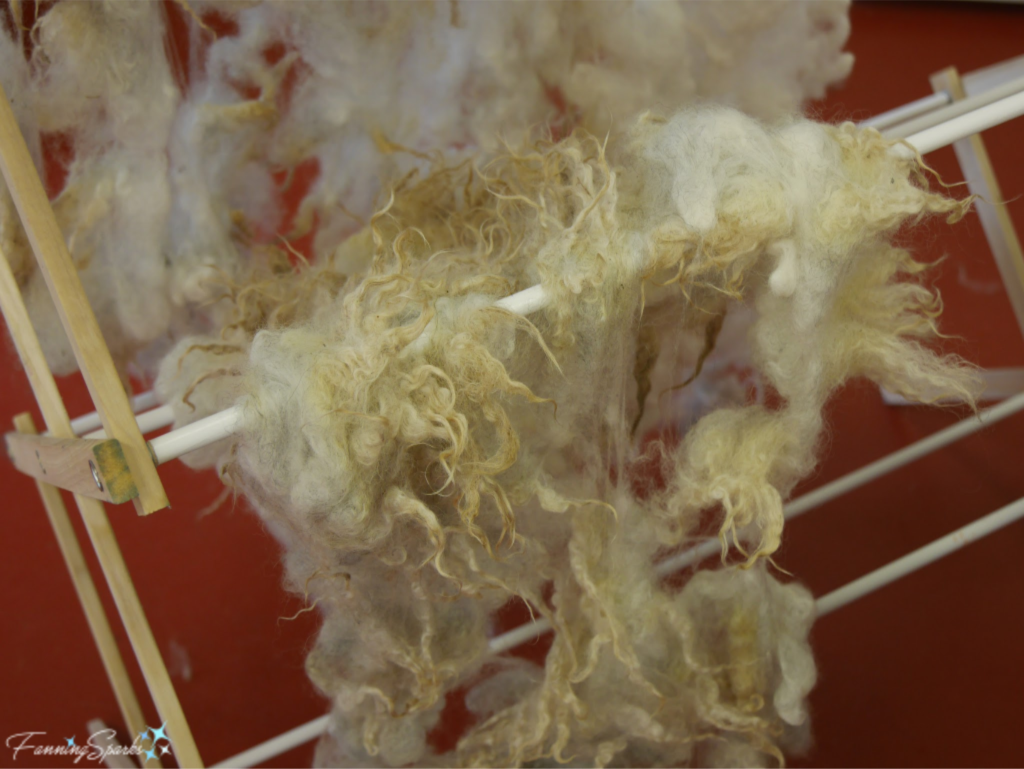 The next day, we skirted the fleece meaning we removed all the nasty bits and vegetable contamination. Then it was time to start discussing natural dyeing… one of my favorite subjects! First we mordanted the wool with alum and cream of tartar to ensure the dyes would fix in the wool.
The next day, we skirted the fleece meaning we removed all the nasty bits and vegetable contamination. Then it was time to start discussing natural dyeing… one of my favorite subjects! First we mordanted the wool with alum and cream of tartar to ensure the dyes would fix in the wool.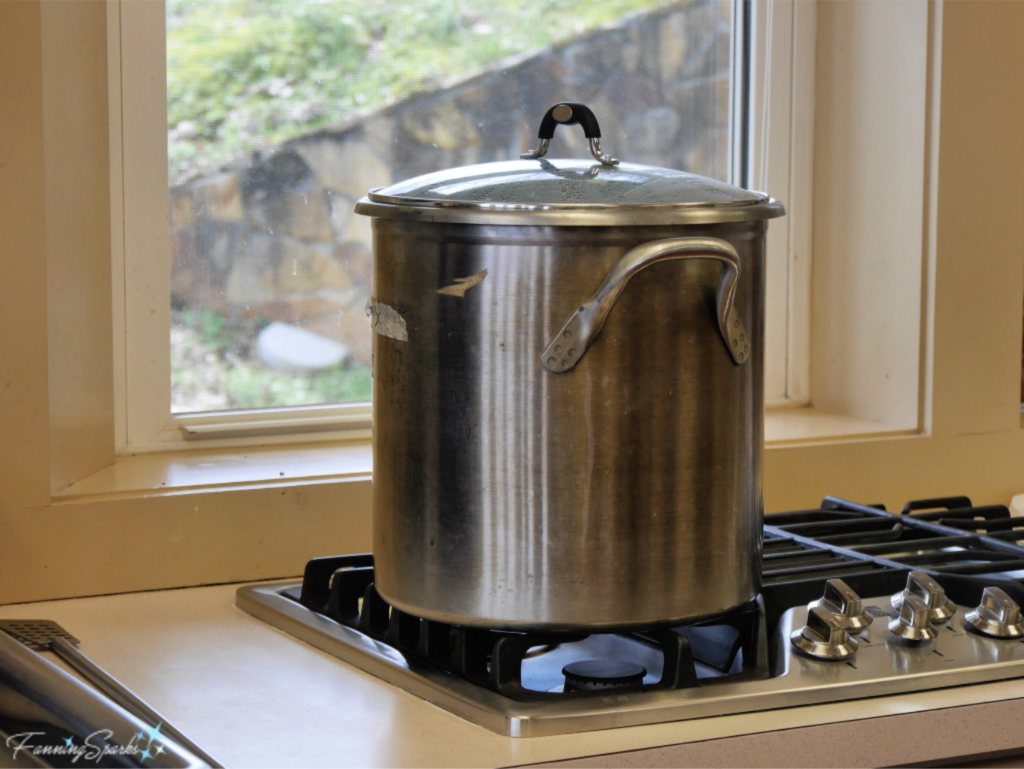 We started experimenting with various dyestuffs. We filled separate dye pots with marigolds, onion skins and cochineal. Then we doubled our options by adding iron or overdyeing. We were pleasantly surprised every time wool was pulled out of a dye pot. The below dye is cochineal‒a natural red dye prepared from the dried bodies of the cochineal insect.
We started experimenting with various dyestuffs. We filled separate dye pots with marigolds, onion skins and cochineal. Then we doubled our options by adding iron or overdyeing. We were pleasantly surprised every time wool was pulled out of a dye pot. The below dye is cochineal‒a natural red dye prepared from the dried bodies of the cochineal insect.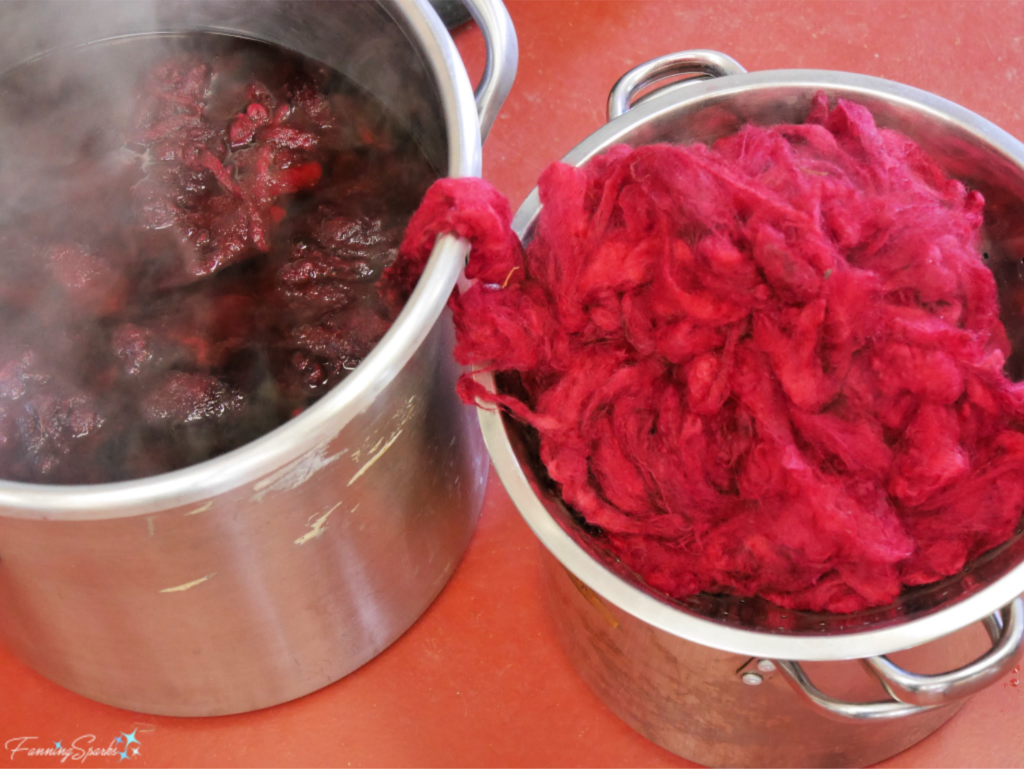 We also made a “rainbow pot” by layering the various dyestuffs, cheesecloth, and wool. Here’s how that wool turned out. Isn’t it pretty?
We also made a “rainbow pot” by layering the various dyestuffs, cheesecloth, and wool. Here’s how that wool turned out. Isn’t it pretty?
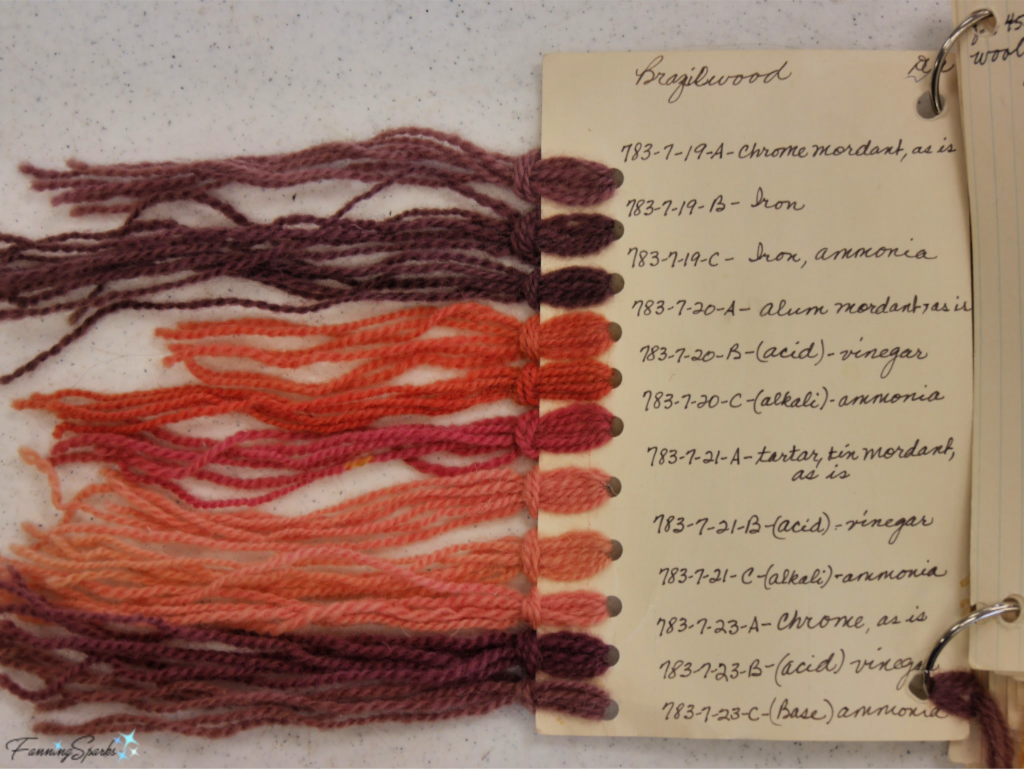 As our dyed wool dried, we shifted back to preparing the wool. We learned to card wool, first with hand carders then with a drum carder.
As our dyed wool dried, we shifted back to preparing the wool. We learned to card wool, first with hand carders then with a drum carder.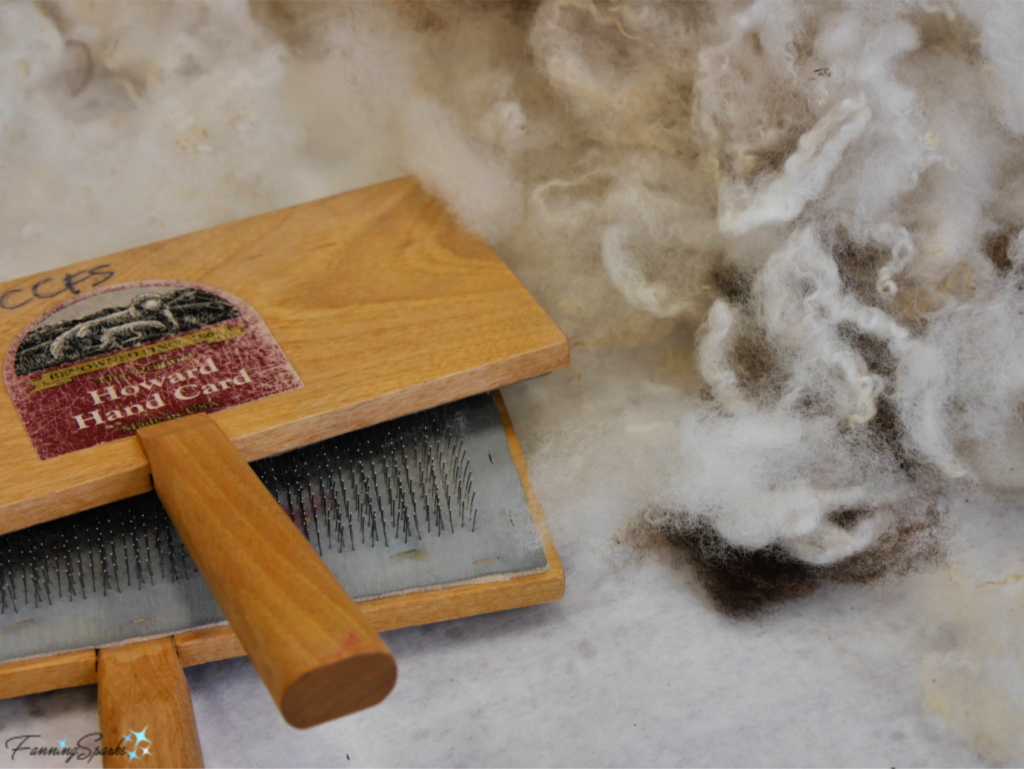 As you might expect, the drum carder was much faster and easier.
As you might expect, the drum carder was much faster and easier.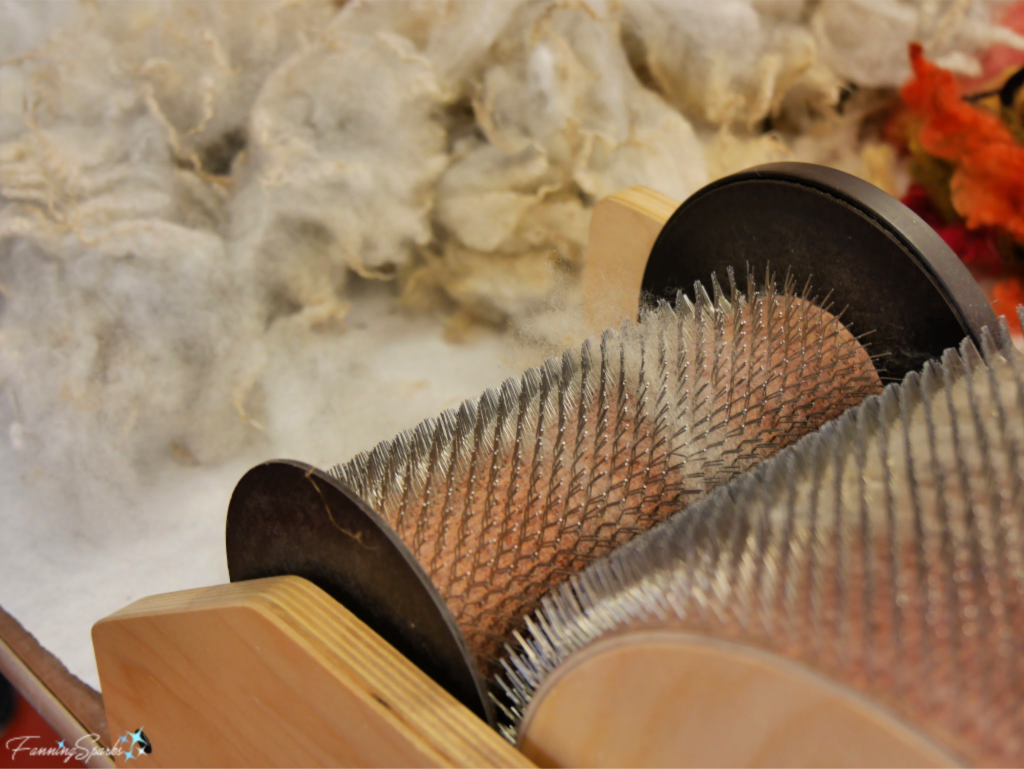 We did a bit of combing. But the bulk of our time was spent learning to spin. Here’s the spinning wheel I attempted to use.
We did a bit of combing. But the bulk of our time was spent learning to spin. Here’s the spinning wheel I attempted to use.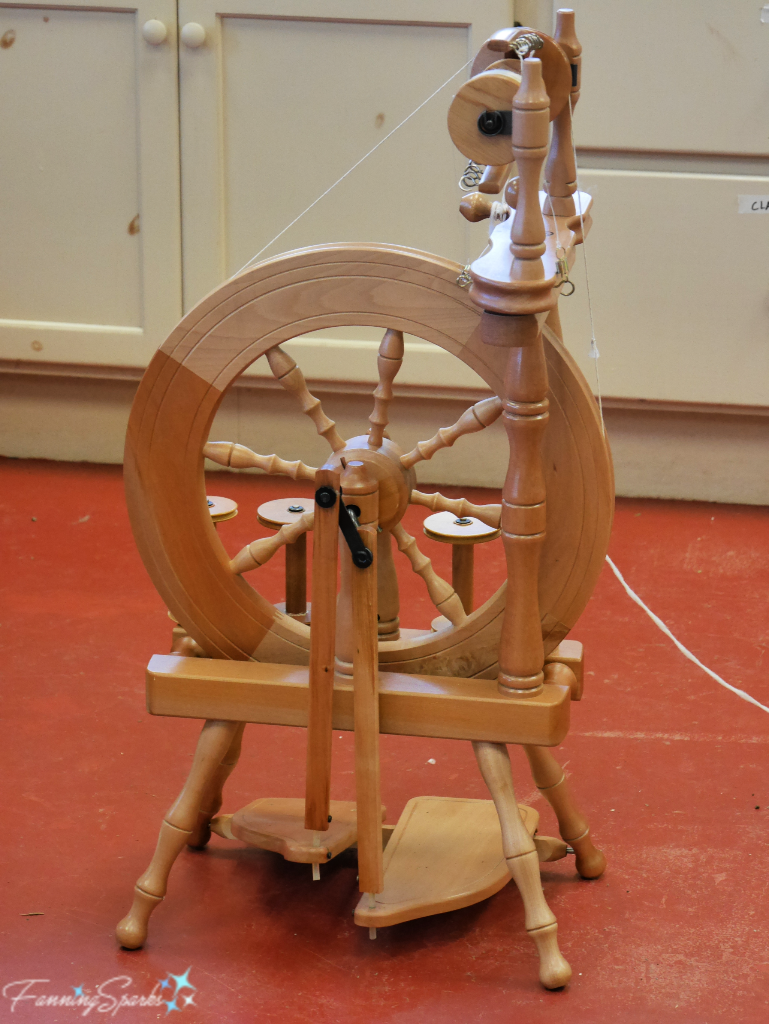
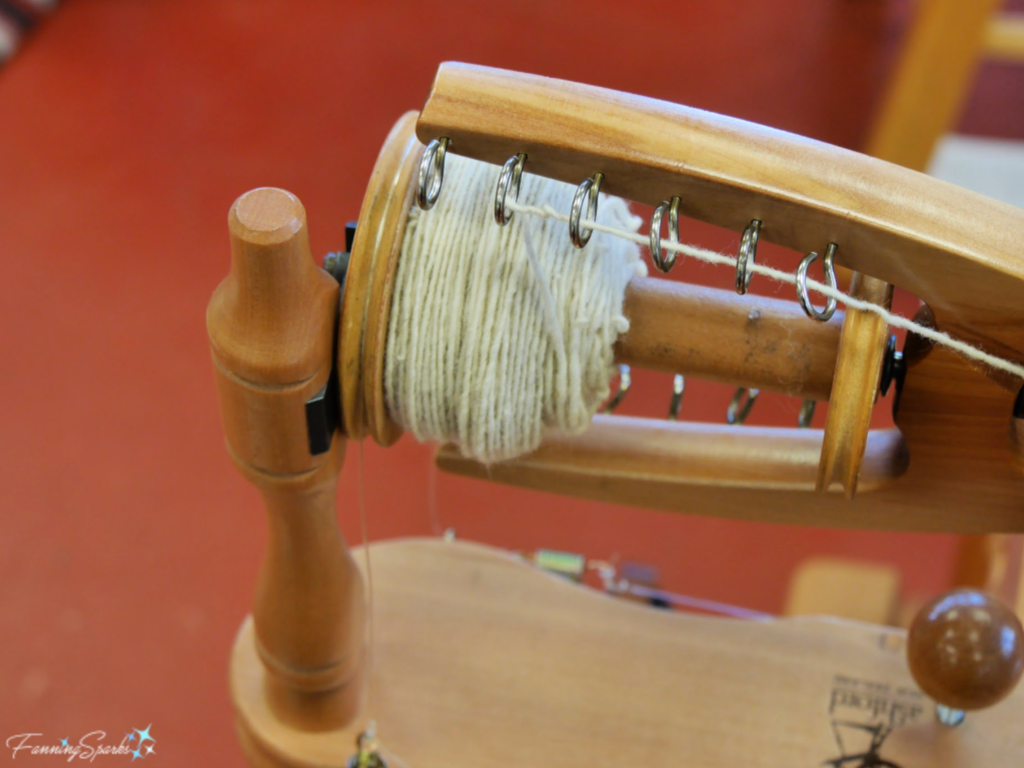 I should add the rest of the class did catch on and lots of beautiful yarn was spun. Here’s the class display for the Student Exhibit at the end of the week.
I should add the rest of the class did catch on and lots of beautiful yarn was spun. Here’s the class display for the Student Exhibit at the end of the week. I learned a variety of new skills and have a new appreciation for the journey wool makes from sheep to shawl. Special thanks to Martha Owen and my fellow students for a great week!
I learned a variety of new skills and have a new appreciation for the journey wool makes from sheep to shawl. Special thanks to Martha Owen and my fellow students for a great week!